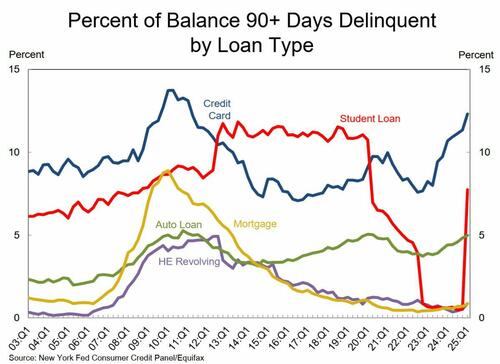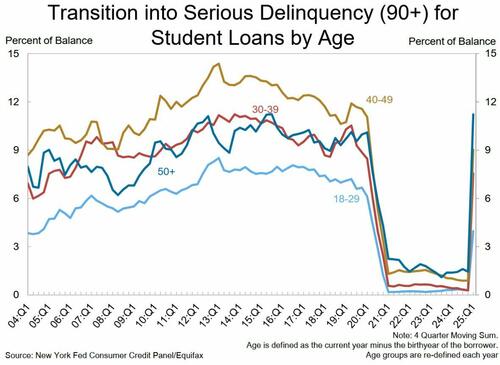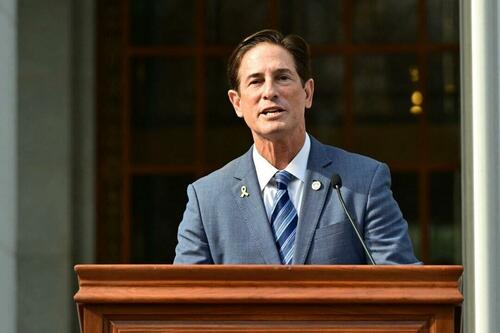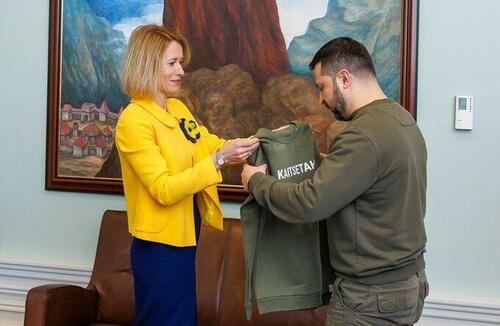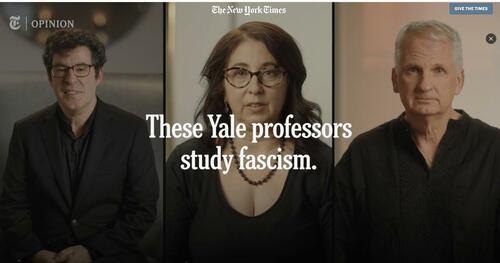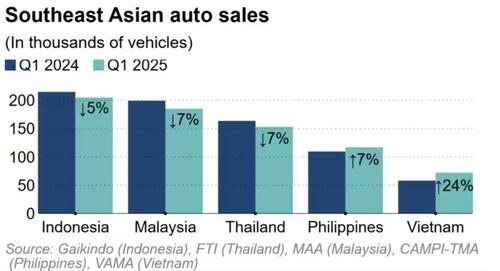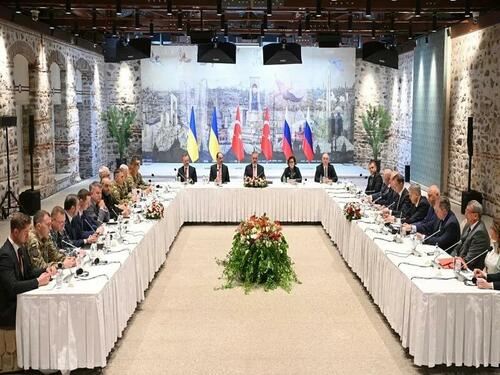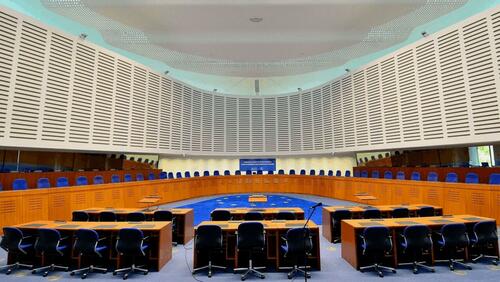For many people today, practical atheism is the normal rule of life...If this attitude becomes a general existential position, then freedom no longer has any standards, then everyting is possible and permissible.
Distinction Matter - Subscribed Feeds
-
Site: Zero Hedge"I Don't Know What To Do!": Borrowers Report Credit-Score Carnage As Student Loans Hit ReportsTyler Durden Sat, 05/17/2025 - 20:25
Last week we noted new report from the New York Federal Reserve, which showed that while Americans' credit card debt is falling, credit scores are starting to decline due to an uptick in student loan delinquencies.
The NY Fed's Center for Macroeconomic Data's quarterly report reveals that overall household debt rose by $167 billion - with credit card debt declining by $29 billion. Yet, the delinquency rate for student loans surged from below 1% to nearly 7.7% after a pandemic-era pause on student loan payments was lifted in September 2023.
While the payments were resumed, policymakers extended a one-year ramp-up period that shielded borrowers' missed payments from being reported to credit bureaus. This extension expired in October 2024, with delinquencies starting to hit the first quarter of 2025.
Needless to say, it's total carnage among borrowers, as one can see from Reddit's 'StudentLoans' forum.
"My credit score dropped 240+ points. i dont know what to do!!" said one Redditor, who says she can't pay her bills because she doesn't have a job after graduating in 2024.
"My score was in the high 700s and dropped to about 480," said another Redditor, who said they were notified by reporting agency Experian that their credit "took a massive hit."
"My transunion and equifax scores took a -100 hit due to my loans "just being recognized this January,"" reported another borrower.
"My credit dropped from a 720 to a 550," said yet another - who reported having "6 total loans from school" that have been "deferred for a while."
"Credit Got Torched" reads a Friday post. "i am unfortunately 1 of the 9 million people who received delinquency marks on my credit report from the dept of education for student loans, which decreased my credit score by 118 points."
Interestingly, several redditors said their scores tanked from loans taken out in their names that they were unaware of - including the first example, who said "I have 10 student loans overall, 5 sub, 5 unsub, and have never had anything else on my credit or anything, no cards or loans, etc. I did get my identity stolen, but I disputed the loans that were taken out fraudulently, and my score was barely affected at all from it."
According to the NY Fed report, while over half of the newly delinquent borrowers already have subprime credit scores, around 2.4 million borrowers who entered delinquency this year had scores over 620 - which could have allowed them to qualify for auto loans, mortgages, and credit cards, prior to the delinquency being reported. 3.2 million borrowers whose scores were under 620 (56.6% of the newly delinquent population) saw their scores decline by an average of 74 points.
Another 2 million borrowers with scores between 620 - 719 (35.9% of new delinquencies) saw their credit scores fall by an average of 140 points - while there were 400,000 borrowers whose scores were above 720 (7.2% of new delinquencies) that saw their scores fall by over 100 points.
Over 1 million borrowers saw drops of at least 150 points.
The report found that seven states have a conditional student loan delinquency rate — which excludes borrowers who don't have a payment due — above 30%, including Mississippi (44.6%), Alabama (34.1%), West Virginia (34%), Kentucky (33.6%), Oklahoma (33.6%), Arkansas (33.5%) and Louisiana (31.8%).
At the end of the first quarter, over 20 million federal student loan borrowers weren't in repayment and five million had a zero-dollar monthly payment. -Fox News
"After a five-year hiatus, student loan delinquency has returned to the pre-pandemic 'normal' with more than 10 percent of balances and roughly six million borrowers either past due or in default," according to the NY Fed report, which noted that the collections process that resumed in May includes the "garnishment of wages, tax returns, and Social Security payments."
"Additionally, millions of borrowers face steep declines in their credit standing which will increase borrowing costs or seriously limit their access to credit like mortgages and auto loans."
-
Site: RT - News
Romania’s George Simion claims authorities in neighboring Moldova are sabotaging his campaign
Romania’s Eurosceptic presidential candidate George Simion has accused the pro-EU government in neighboring Moldova of attempting to rig Sunday’s runoff vote. The leader of the Alliance for the Union of Romanians (AUR) came in first in the initial round of the presidential election rerun on May 4, securing more than 40% of the vote.
Roughly 30% of Moldova’s population are dual Moldovan-Romanian citizens. Simion’s supporters argue that early turnout among Romanians voting in Moldova is suspiciously high – nearly three times the level recorded during the same period in the first round.
“Enough campaigning – now we have to stop the massive fraud! The government in Moldova has started stealing votes. We won’t let them!” Simion wrote on Facebook on Friday.
The AUR has claimed that Moldova’s ruling Party of Action and Solidarity (PAS) has been directing voters to support Simion’s opponent, Bucharest Mayor Nicusor Dan. “By 1 p.m., over 50,000 votes had been cast by the diaspora – an increase of almost 70% compared to the first round. These figures are no coincidence,” the party wrote on its website.
Read more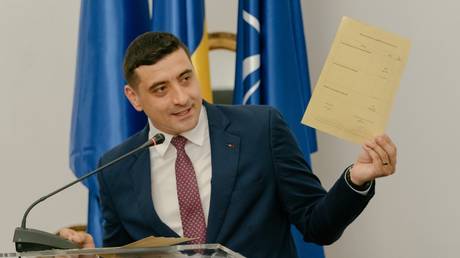 Romanian presidential frontrunner slams ‘authoritarian’ Macron
Romanian presidential frontrunner slams ‘authoritarian’ Macron
The AUR also accused Moldova’s broadcaster Pro TV Chisinau of waging “an illegal and partisan campaign in favor of the establishment candidate” and of voter manipulation “under the guise of independent journalism.”
Chisinau has denied any interference in Romania’s election. “Out of respect for the voters, we urge all political actors to refrain from making accusations that only serve to undermine this democratic exercise,” government spokesman Daniel Voda said. He encouraged Romanian nationals living in Moldova to cast their ballots “without fear.”
The election rerun was ordered after Romania’s Constitutional Court annulled the results of the November vote, in which independent right-wing candidate Calin Georgescu came first with 23%. Authorities cited “irregularities” in his campaign, along with intelligence reports alleging Russian interference – claims Moscow has strongly denied.
Simion condemned the annulment of the 2024 election results as a “coup d’état.” He is currently banned from entering Moldova, which he has called “an artificial country” that “will never join the European Union.”
-
Site: Zero HedgeLos Angeles County Targets Retail Theft With New Warning ProgramTyler Durden Sat, 05/17/2025 - 19:50
Authored by Jill McLaughlin via The Epoch Times,
Los Angeles County is launching a new program to warn criminals and deter retail theft, according to District Attorney Nathan Hochman, who says local businesses have lost millions of dollars to theft since January.
Retailers can contact local law enforcement to obtain one of 10,000 yellow warning decals to post at their business and inform the public that thefts will be prosecuted by the regional retail theft task force.
The sticker also has a QR code for the public to use to report any crimes.
According to the National Retail Federation, the Los Angeles area is the worst in the nation for organized retail crime.
At a press conference on May 14 in front of a 7-Eleven convenience store in West Los Angeles, Hochman said ending the cycle of catch-and-release in recent years that sent serial retail thieves back on the streets to reoffend is a top priority.
“Small businesses, stores, and even big-box retailers constitute the lifeline of our communities, and the lifeblood of our communities are under attack,” Hochman said.
“They’ve had to deal over the last several years with criminals who had the mistaken belief that you can come into a 7-Eleven, for instance, take whatever you want, leave, and nothing would happen.
“We are here today to explain to them the exact opposite,” he said. “You will be held accountable, you will be arrested, you will be prosecuted to the fullest extent of the law.”
The district attorney said he intended to use new authority afforded by Proposition 36, passed by state voters last year, to prosecute thieves and repeat offenders.
The proposition—also known as the “Homelessness, Drug Addiction, and Theft Reduction Act,” went into effect on Dec. 18, 2024.
The new law increased penalties for certain drug and theft crimes, and reclassified some misdemeanors as felonies for repeat offenders. The penalties can include sentences of up to three years in jail or prison if the defendant has already been convicted for certain thefts.
Since December, the county has filed over 1,000 Prop. 36 felony theft charges against repeat offenders, according to Hochman.
“We are armed with an additional set of laws under Prop. 36,” Hochman said.
Los Angeles County District Attorney Nathan Hochman said 10,000 warning decals will be available for local stores beginning May 16, 2025. Los Angeles County District Attorney's Office
Before Prop. 36 went into effect, petty thefts under $950 were classified as misdemeanors, and thefts could not be aggregated to meet the felony threshold, creating a “culture of impunity,” Hochman’s office stated.
One of the felony arrests made since the new law took effect was of Corry Summerville, 38, who was allegedly a serial shoplifter at the 7-Eleven featured in the news conference.
Summerville has been charged with 12 felony charges and one count of robbery related to alleged thefts at the convenience store owned by franchisee Jawad Ursani between January and March.
Four employees resigned, allegedly out of fear of continued encounters with Summerville, according to the Los Angeles Police Department Commanding Officer Capt. Richard Gabaldon.
One of the employees was allegedly violently assaulted when he asked Summerville to pay for items.
“We commend the victim for ultimately coming forward,” Gabaldon said at the news conference.
Los Angeles Councilwoman Katy Yaroslavsky, who represents the district where the 7-Eleven is located, said her family often frequented the store.
“When a store is repeatedly targeted or a theft turns violent, it does more than hurt the business,” Yaroslavsky said at the event. “It makes you wonder if it’s safe to send your kids in. It makes you worry that someone could get caught in the middle. And it makes you feel like no one is in charge.”
The district attorney is also partnering with local, state, and federal law enforcement agencies to investigate and prosecute organized retail crime. Investigators are targeting serial shoplifters, smash-and-grab mobs, and large-scale criminal enterprises.
“This is a warning to all the criminals out there, if you come to these stores and think you’re going to come here and commit a crime, we’re going to arrest you and present a good case to the D.A., and you will go to jail for that,” said LAPD Capt. Francis Boateng, commanding officer of the department’s commercial crimes division.
Convenience store owner Ursani, who has operated the 7-Eleven featured at the news conference for more than 25 years, said he was grateful for the support from Hochman and the law enforcement communities.
“My store was targeted not once, but twice, by a smash-and-grab of about over 50 teenagers and a repeat [alleged] shoplifter who is now detained and will be held accountable by this D.A.’s office as we speak,” Ursani said. “Each incident costs us in stolen goods, broken equipment, staff morale, and personal safety.”
Ursani said he has had to spend thousands of dollars on protection for the store, instead of spending the money on inventory and community investments.
“It’s not just about theft, it’s about fear and instability it brings to everyone who depends on this store and our entire community,” Ursani added.
Prop. 36 has given law enforcement more tools to target operations that harm communities, according to Los Angeles County Sheriff’s Department Detective Division Chief Joe Mendoza.
“While Proposition 36 promotes necessary criminal justice reform, it also allows us to focus resources on serious, organized theft operations that harm our communities,” Mendoza said.
-
Site: Fr. Z's BlogLeo XIV’s “Fisherman’s Ring” for the beginning of his pontificate. Not bad. A0 L’Anello del Pescatore, che sarà consegnato a Papa Leone XIV durante la celebrazione per l’inizio del Ministero Petrino, su cui è raffigurata l’immagine di San Pietro con … Read More →
-
Site: Zero Hedge"Black Fatigue" Goes Viral: Everyone Including Blacks Is Tired Of Ghetto BehaviorTyler Durden Sat, 05/17/2025 - 19:15
The progressive ideal is largely to blame for the monstrous creation that is ghetto culture. The idea that racial narcissism among blacks should not only be tolerated but celebrated has led to a surge in open animosity for societal rules and standards within the US. Far more than any other group, the black community makes up the largest share of physical crime according to their percentage of the population. This includes robbery, aggravated assault, and homicides.
For example, black Americans make up only 13% of the population but commit around 52% of all homicides according to FBI statistics. The recent case of Karmelo Anthony comes to mind, a black teen who admitted to stabbing a white teen and killing him because the white teen allegedly "pushed him" (which he argues was a threat that made deadly force justifiable).
The concept of "disrespect" as an offense that justifies murder is only one problem. There is an identifiable trend of theatrical sociopathy within the black community that goes far beyond the norm. The prevailing theory is that this is predominantly cultural - Black Americans have the highest rate of single parent households in the country (50% of black homes compared to 20% of white homes in 2023). Most of these households are run by single mothers. Single mother homes are a notorious indicator of future criminality among juveniles.
Then there is the problem of racial victim culture; the false idea that black Americans are being "oppressed" in the US by a systemic conspiracy of white patriarchs. In reality, white Americans have been exponentially tolerant and have provided special privileges for blacks (affirmative action and DEI), largely because progressive society demands that reparations be made for slavery 150 years ago and segregation 60 years ago. The form of those reparations has more or less been white guilt and a quiet passiveness in the face of increasing antagonism.
Leftists claim white people should take it because historically they deserve it. Ignore the fact that every culture on Earth had institutional slavery and all the slaves sent to the Americas were purchased from African tribes that enslaved other African tribes.
However, it appears that the black community's precious supply of white guilt has finally run out and people are fed up. The term "Black Fatigue" has gone viral this week on social media, sparking a much needed conversation among not just whites, but also blacks and other minorities. The catalyst blamed for the trend is the now widely known "Shiloh Hendrix Incident" which has led to public support and an uproar among progressives who demand the woman be prosecuted for dropping an N-bomb.
I don’t think it’s so much “black fatigue” as it is POS fatigue which you can see in various races.
— Brandon Morse (@TheBrandonMorse) May 12, 2025
For instance, white people are sick of Antifa and radical leftists who coat their entitlement and destruction with pseudo-morality. Hispanic people don’t like border hoppers who… pic.twitter.com/yaHMKKnlj3Perhaps white Americans finally speaking up instead of remaining silent is what was needed all along. The fear has not been so much about black reprisal, but reprisal from the leftist mob, which until recently had weaponized cancel culture to destroy the lives of anyone speaking outside of prescribed leftist opinions.
The following clips illustrate Black Fatigue in the most symbolic way possible: An arrogant desire to destroy what other groups build, no matter how meaningless and petty the situation might be. Never helping, never cooperating, never trying to make things better.
Black fatigue
— The General (@1776General_) May 17, 2025
Who has it? pic.twitter.com/x0aoz9AKBNAnd an egotistical need to display power over other groups (especially white people) by sabotaging them even though they have done nothing wrong and want to be left alone. Oversensitive reactions to every perceived slight, creating a psychology of persecution that leads blacks to lash out over everything. These are habits not limited to individuals, but habits of the culture as a whole.
This black mother is absolutely terrible as she teaches her baby girl to bully white girls, whom she captions as “baby Karens” in her video. pic.twitter.com/L5ExtXYZGL
— Ian Miles Cheong (@stillgray) September 19, 2024Black fatigue is leading to a dangerous place and it's clear that at least some in the community see what is happening and they're trying to mitigate the damage. Historically speaking, the next stage would be mass anger and retaliation for such behaviors.
Hopefully it won't come to that. If ghetto culture is abandoned and calmer minds prevail then it's likely most racial strife within the US today will disappear as quickly as it gestated. But this would require that a large portion of black Americans accept the reality that they are not victims and that they are causing the problem. How likely is it that this will happen given decades of woke indoctrination that says white people are always the source of every conflict and trespass?
* * *
Grow your own food with HEIRLOOM SEEDS (39 varieties - 4,500 seeds) from ZH Store! Free shipping in the USA.
 Click pic... buy seeds... take food supply into your own hands...
Click pic... buy seeds... take food supply into your own hands... -
Site: Henrymakow.com
 Please send links and comments to hmakow@gmail.comThis tweet hit a nerve. It got 600 likes and 100 comments.Can we count the gays? Mark Carney is gay.(This article is being shadow banned by all search engines including Yandex)British PM, Queer Charmer, probably gay too. Obama. Fidelito. Klaws Swab. Yuval Harari.Look at this video of Zelensky in high heels.The Illuminati are a degenerate homosexual cult. Like Communist Jews, some homosexuals feelexcluded from society and are taking revenge by destroying it. Cabalist Jews and gays are natural subversives. Cabalist Jews are metaphysical outcasts because they think they're God. Gays are biological outcasts.Like Commie/Zionist Jews, many homosexuals have trouble getting a handle on morality.Quote from Mae West's autobiography, "Goodness Had Nothing to do with It" (1959): "In many ways homosexuality is a danger to the entire social system of Western civilization. Certainly a nation should be made aware of its presence -- without moral mottoes -- and its effects on children recruited to it in their innocence. I had no objection to it as a cult of jaded inverts... involved only with themselves. It was its secret, anti-social aspects I wanted to bring into the sun. As a private pressure group it could, and has, infected whole nations."-------Lena Petrova- Fiscal Crisis INEVITABLE: Washington's $37 Trillion Debt Addition Nears Collapse - Who Owns US Debt?80% of the 37 trillion debt is held by the puvlicEvery three month US debt increase by 1 trillion-
Please send links and comments to hmakow@gmail.comThis tweet hit a nerve. It got 600 likes and 100 comments.Can we count the gays? Mark Carney is gay.(This article is being shadow banned by all search engines including Yandex)British PM, Queer Charmer, probably gay too. Obama. Fidelito. Klaws Swab. Yuval Harari.Look at this video of Zelensky in high heels.The Illuminati are a degenerate homosexual cult. Like Communist Jews, some homosexuals feelexcluded from society and are taking revenge by destroying it. Cabalist Jews and gays are natural subversives. Cabalist Jews are metaphysical outcasts because they think they're God. Gays are biological outcasts.Like Commie/Zionist Jews, many homosexuals have trouble getting a handle on morality.Quote from Mae West's autobiography, "Goodness Had Nothing to do with It" (1959): "In many ways homosexuality is a danger to the entire social system of Western civilization. Certainly a nation should be made aware of its presence -- without moral mottoes -- and its effects on children recruited to it in their innocence. I had no objection to it as a cult of jaded inverts... involved only with themselves. It was its secret, anti-social aspects I wanted to bring into the sun. As a private pressure group it could, and has, infected whole nations."-------Lena Petrova- Fiscal Crisis INEVITABLE: Washington's $37 Trillion Debt Addition Nears Collapse - Who Owns US Debt?80% of the 37 trillion debt is held by the puvlicEvery three month US debt increase by 1 trillion- How a dollar crisis would unfold If investors keep selling American assets, a grim fate awaits the world economyThe US has lost its last perfect credit rating, as influential ratings firm Moody's expressed concern over the government's ability to pay back its debt.In lowering the US rating from 'AAA' to 'Aa1', Moody's noted that successive US administrations had failed to reverse ballooning deficits and interest costs.A triple-A rating signifies a country's highest possible credit reliability, and indicates it is considered to be in very good financial health with a strong capacity to repay its debts.Moody's warned in 2023 the US triple-A rating was at risk. Fitch Ratings downgraded the US in 2023 and S&P Global Ratings did so in 2011. Moody's held a perfect credit rating for the US since 1917.Stew Peters--P DIDDLER TRIAL, EXPOSING ISRAEL, TRUMP AND OTHERS EXPOSED!-Leonard Ulrich - NWO Report: Project FEAR / The Trump DeceptionBibi Netanyahu is like an uncle to Jared Kushner--Arab league: "This genocide [in Gaza] has reached a level of ugliness unparalleled in all conflicts in history."Quote: "The time for a moral reckoning over the treatment of Palestinians has come - and it is long overdue," said Dora Bakoyannis, rapporteur for the Middle East at the Parliamentary Assembly of the Council of Europe.--Stew Peters-HOAX Alert - Trump-Netanyahu 'Break up' is a False Flag--
How a dollar crisis would unfold If investors keep selling American assets, a grim fate awaits the world economyThe US has lost its last perfect credit rating, as influential ratings firm Moody's expressed concern over the government's ability to pay back its debt.In lowering the US rating from 'AAA' to 'Aa1', Moody's noted that successive US administrations had failed to reverse ballooning deficits and interest costs.A triple-A rating signifies a country's highest possible credit reliability, and indicates it is considered to be in very good financial health with a strong capacity to repay its debts.Moody's warned in 2023 the US triple-A rating was at risk. Fitch Ratings downgraded the US in 2023 and S&P Global Ratings did so in 2011. Moody's held a perfect credit rating for the US since 1917.Stew Peters--P DIDDLER TRIAL, EXPOSING ISRAEL, TRUMP AND OTHERS EXPOSED!-Leonard Ulrich - NWO Report: Project FEAR / The Trump DeceptionBibi Netanyahu is like an uncle to Jared Kushner--Arab league: "This genocide [in Gaza] has reached a level of ugliness unparalleled in all conflicts in history."Quote: "The time for a moral reckoning over the treatment of Palestinians has come - and it is long overdue," said Dora Bakoyannis, rapporteur for the Middle East at the Parliamentary Assembly of the Council of Europe.--Stew Peters-HOAX Alert - Trump-Netanyahu 'Break up' is a False Flag-- "This is a picture of me pulling my niece out from under the rubble after the house was targeted over our heads.""No one can imagine the amount of suffering and pain we live through every day here. Everything has become almost impossible. Getting water has become almost impossible, and getting firewood to light a fire has become one of the most difficult daily things because of the firewood running out. The pain of sitting in front of the fire to cook food is enough, which causes serious and dangerous diseases for us. But unfortunately, no one feels for us here, and no one intends to do anything for us. The whole world has let us down and has begun to see what we suffer and go through."Tonight, as I speak to you, the occupation forces launched a violent series of raids, and they entered the place by ground force, besieged the families, and arrested them. I miraculously escaped from the place, and now, as you can see, I am sitting in the street with many families, and there is no place for me or them to flee to. This is the second displacement in a week, and the second escape from death.A Way to Help Gaza-100 photos from PalestineA glimpse into the people, places and daily life in Palestine before the 1948 Nakba.This collection of 100 archived images of life in Palestine before the 1948 Nakba, when Zionist militias expelled at least 750,000 Palestinians and captured 78 percent of historical Palestine. Browse through Palestine as it was: people, places, and life and culture.-
"This is a picture of me pulling my niece out from under the rubble after the house was targeted over our heads.""No one can imagine the amount of suffering and pain we live through every day here. Everything has become almost impossible. Getting water has become almost impossible, and getting firewood to light a fire has become one of the most difficult daily things because of the firewood running out. The pain of sitting in front of the fire to cook food is enough, which causes serious and dangerous diseases for us. But unfortunately, no one feels for us here, and no one intends to do anything for us. The whole world has let us down and has begun to see what we suffer and go through."Tonight, as I speak to you, the occupation forces launched a violent series of raids, and they entered the place by ground force, besieged the families, and arrested them. I miraculously escaped from the place, and now, as you can see, I am sitting in the street with many families, and there is no place for me or them to flee to. This is the second displacement in a week, and the second escape from death.A Way to Help Gaza-100 photos from PalestineA glimpse into the people, places and daily life in Palestine before the 1948 Nakba.This collection of 100 archived images of life in Palestine before the 1948 Nakba, when Zionist militias expelled at least 750,000 Palestinians and captured 78 percent of historical Palestine. Browse through Palestine as it was: people, places, and life and culture.- Slovak PM Robert Fico Expected To Survive; UK Media Appears To Justify Assassination AttemptPrime Minister Fico is said to be improving, following reports that he was in surgery due to several gunshot wounds from the Wednesday assassination attempt. Deputy Prime Minister Tomas Taraba has told the BBC he "is not in a life-threatening situation at this moment.""Fortunately, as far as I know, the operation went well - and I guess in the end he will survive," the statement indicated. Deputy Prime Minister Robert Kalinak has told reporters in a briefing that "there is no doubt" that the attack was a politically motivated assassination attempt.Pro-Ukrainian Liberal tries to ASSASSINATE Slovakia's anti-war Prime Minister | Redacted News---Martin Armstrong - WEF staged a coup and got rid of Klaws SwabCatherine Austin Fitts - 170 UNDERGROUND BASES CONNECTED BY RAILBuilt in preparation for a "total extinction event"-Vaccinated people no longer human? Classified as "Transhumans"?-Kemi Badenoch, Nigel Farage and Jimmy Carr attend secret Israeli party at British Museum--
Slovak PM Robert Fico Expected To Survive; UK Media Appears To Justify Assassination AttemptPrime Minister Fico is said to be improving, following reports that he was in surgery due to several gunshot wounds from the Wednesday assassination attempt. Deputy Prime Minister Tomas Taraba has told the BBC he "is not in a life-threatening situation at this moment.""Fortunately, as far as I know, the operation went well - and I guess in the end he will survive," the statement indicated. Deputy Prime Minister Robert Kalinak has told reporters in a briefing that "there is no doubt" that the attack was a politically motivated assassination attempt.Pro-Ukrainian Liberal tries to ASSASSINATE Slovakia's anti-war Prime Minister | Redacted News---Martin Armstrong - WEF staged a coup and got rid of Klaws SwabCatherine Austin Fitts - 170 UNDERGROUND BASES CONNECTED BY RAILBuilt in preparation for a "total extinction event"-Vaccinated people no longer human? Classified as "Transhumans"?-Kemi Badenoch, Nigel Farage and Jimmy Carr attend secret Israeli party at British Museum-- Men were brainwashed to love women (sex) more than themselves.A man who does not love himself is not a man. Get the picture?We were psychologically castrated.The Buddha: "So long as the love, even the smallest, of man toward woman is not destroyed, so long is his mind in bondage as the calf that drinks milk is to his mother."-Doug Casey On DOGE, Deficits, & The Coming Financial Earthquake"The only way to solve the problem isn't by making government more efficient, but by abolishing agencies wholesale--not just trimming some fat.Will there be a fundamental change? That's unlikely because, as I've said many times before, Trump has no philosophical center. Nor any understanding of economics, as evidenced by his tariffs scheme, which I think will fail utterly--and may even be the catalyst that sets off the Greater Depression. He's flying by the seat of his pants.For instance, take Ukraine. Zelensky has become a billionaire, as have all his cronies, and the fighting is still going on. Why? Because the US is still sending them money and materiel.I'm afraid serious cuts are bluster, not reality. And where can they really cut things? Are they going to take money away from the Veterans Administration or military pensions?"----Cool? "I'm very concerned for [the president's] life. And James Comey, in my view, should be held accountable and put behind bars for this." -- DNI Tulsi Gabbard---
Men were brainwashed to love women (sex) more than themselves.A man who does not love himself is not a man. Get the picture?We were psychologically castrated.The Buddha: "So long as the love, even the smallest, of man toward woman is not destroyed, so long is his mind in bondage as the calf that drinks milk is to his mother."-Doug Casey On DOGE, Deficits, & The Coming Financial Earthquake"The only way to solve the problem isn't by making government more efficient, but by abolishing agencies wholesale--not just trimming some fat.Will there be a fundamental change? That's unlikely because, as I've said many times before, Trump has no philosophical center. Nor any understanding of economics, as evidenced by his tariffs scheme, which I think will fail utterly--and may even be the catalyst that sets off the Greater Depression. He's flying by the seat of his pants.For instance, take Ukraine. Zelensky has become a billionaire, as have all his cronies, and the fighting is still going on. Why? Because the US is still sending them money and materiel.I'm afraid serious cuts are bluster, not reality. And where can they really cut things? Are they going to take money away from the Veterans Administration or military pensions?"----Cool? "I'm very concerned for [the president's] life. And James Comey, in my view, should be held accountable and put behind bars for this." -- DNI Tulsi Gabbard---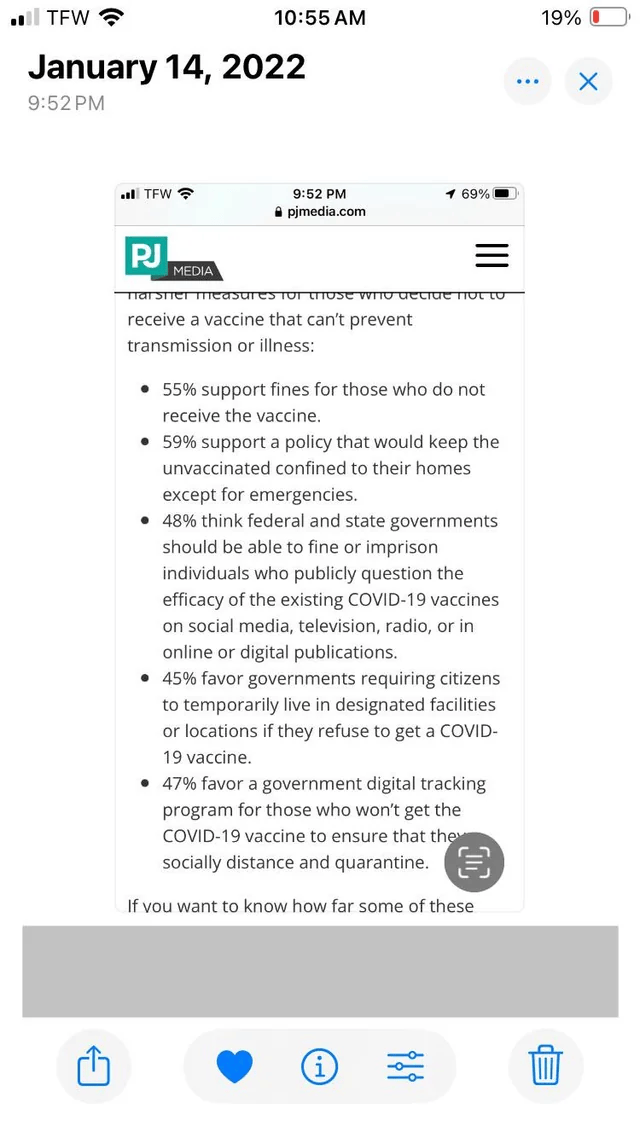 This was a survey of Demonats, worse than NazisAnother Degenerate Commie Jew Behaving BadlyJaw-Dropping Lawsuit Accuses 'New Soros' Of Proposing 'Threesomes', Other Sexual Harassment-"I state without reservation that the United States federal government under Joe Biden and Kamala Harris is the world's largest child sex trafficking organization in modern history. The probability...that thousands of these children are being raped at this very moment is one hundred percent."-IMAGINE THAT: Homicides Are Down 60 Percent in Denver Following ICE Deportations--Thomas Stone on Pastor Chuck BaldwinPastor Baldwin will claim to be an expert on Zionism, but won't discuss the elephant in the room. That'd be too controversial. He claims Zionism is run by a bunch of white Americans and Europeans.•In other words, Pastor Baldwin gets the kosher seal of approval.----Q--Why hasn't Trump exposed the 2020 Presidential election fix?A- Because he was complicit. He took a Fall.--Former Music Exec Describes The Scary Meeting That Resulted In Today's Violent Rap MusicPrison industry profit--
This was a survey of Demonats, worse than NazisAnother Degenerate Commie Jew Behaving BadlyJaw-Dropping Lawsuit Accuses 'New Soros' Of Proposing 'Threesomes', Other Sexual Harassment-"I state without reservation that the United States federal government under Joe Biden and Kamala Harris is the world's largest child sex trafficking organization in modern history. The probability...that thousands of these children are being raped at this very moment is one hundred percent."-IMAGINE THAT: Homicides Are Down 60 Percent in Denver Following ICE Deportations--Thomas Stone on Pastor Chuck BaldwinPastor Baldwin will claim to be an expert on Zionism, but won't discuss the elephant in the room. That'd be too controversial. He claims Zionism is run by a bunch of white Americans and Europeans.•In other words, Pastor Baldwin gets the kosher seal of approval.----Q--Why hasn't Trump exposed the 2020 Presidential election fix?A- Because he was complicit. He took a Fall.--Former Music Exec Describes The Scary Meeting That Resulted In Today's Violent Rap MusicPrison industry profit-- Canadians are richer than they thinkCanadian households were worth more than $1.025 million on average in 2024: How do you stack up?FP Wealth Report: Average household net worth in Canada reached $1,026,205 by the fourth quarter, a 30 per cent jump from pre-pandemic figures"The wealthiest (top 20 per cent) accounted for nearly two-thirds of Canada's total net worth in the fourth quarter, averaging $3.3 million per household. In comparison, the bottom 40 per cent of the wealth distribution made up just 3.3 per cent, averaging $84,600 per household."--Chinese Kill Switches Found in US Solar Farmshttps://www.reddit.com/r/conspiracy/comments/1ko2noc/chinese_kill_switches_found_in_us_solar_farms/#lightbox-
Canadians are richer than they thinkCanadian households were worth more than $1.025 million on average in 2024: How do you stack up?FP Wealth Report: Average household net worth in Canada reached $1,026,205 by the fourth quarter, a 30 per cent jump from pre-pandemic figures"The wealthiest (top 20 per cent) accounted for nearly two-thirds of Canada's total net worth in the fourth quarter, averaging $3.3 million per household. In comparison, the bottom 40 per cent of the wealth distribution made up just 3.3 per cent, averaging $84,600 per household."--Chinese Kill Switches Found in US Solar Farmshttps://www.reddit.com/r/conspiracy/comments/1ko2noc/chinese_kill_switches_found_in_us_solar_farms/#lightbox- -
Site: RT - News
Imposing new restrictions against the backdrop of peace talks between Moscow and Kiev is wrong, Slovak Prime Minister Robert Fico believes
The EU is wrong to slap Russia with a fresh round of sanctions against the backdrop of peace talks between Moscow and Kiev, Slovak Prime Minister Robert Fico has said. He compared the restrictions to a “plague” and stated that they do more harm to the bloc itself while hardly affecting Russia.
EU ambassadors on Wednesday approved a 17th package of sanctions against Russia, which targets nearly 200 oil tankers that the West claims are part of Russia’s “shadow fleet.” These are older vessels that operate outside the Western insurance system. The move came just two days before a meeting between Russian and Ukrainian delegations in Istanbul in what were the first direct peace talks between the two sides in three years.
“Sanctions are like a plague and I reject the sanctions policy,” Fico told the Slovak STVR broadcaster, maintaining that the restrictions imposed by Brussels have so far only damaged the EU. He believes that Russia managed to quickly adapt to all the punitive measures.
Read more EU mulling ‘punitive’ new tariffs on Russia – Politico
EU mulling ‘punitive’ new tariffs on Russia – Politico
Fico also said he would support a national referendum on rejecting EU sanctions on Russia should someone call for one. If any new restrictions risk damaging the Slovak economy, he will veto them at the EU level, he stated.
The Slovak leader also said that he discussed a potential ceasefire between Russia and Ukraine with Russian President Vladimir Putin during his visit to Moscow earlier in May. According to Fico, diplomacy is still the best way to resolve the Ukraine conflict, with negotiations between Putin and US President Donald Trump being key to reaching a settlement.
On Friday, Moscow and Kiev agreed to a major prisoner swap and decided to continue contacts once each side prepares a detailed ceasefire plan and presents it to the other. Following the talks, several EU nations called for more pressure against Moscow. French Foreign Minister Jean-Noel Barrot stated that the EU and US must “suffocate” the Russian economy “once and for all.”
Slovakia took what Fico calls a “constructive” and pragmatic approach towards Russia upon coming to power in 2023. “Europe needs Russia, and Russia needs Europe,” he said in a video message last week, reflecting on his visit to Moscow. “We must pursue a policy of cooperation, not one of hatred and iron curtains.”
-
Site: RT - News
Romania’s George Simion and Poland’s Karol Nawrocki have vowed to oppose Brussels’ policies and build stronger ties with Donald Trump’s America
A joint election campaign rally by Romanian election frontrunner George Simion and Polish presidential candidate Karol Nawrocki have announced plans for what the former described as a “pro-MAGA” union at a joint rally the two held earlier this week in Poland. Supporters at the event chanted the name of US President Donald Trump.
Both EU nations are heading into presidential elections this Sunday. Poland will hold the first round of voting, while Romania will see a runoff between Simion and Bucharest Mayor Nicusor Dan.
Speaking at the rally in support of Nawrocki in Zabrze on Tuesday, Simion vowed to reverse what he called an “anti-American change in Europe.” A critic of the EU who has been banned from entering Ukraine, Simion won the first round of the presidential election rerun in Romania on May 4 with more than 40% of the vote.
His words prompted the crowd to begin chanting: “Donald Trump! Donald Trump!” The politician joined the chant and called the American leader “not just a person but a symbol of freedom.”
George Simion, who is a presidential candidate in Romania, came to support Karol Nawrocki at his rally.
— Savvy Feline (@Savvy_Feline) May 14, 2025
Karol Nawrocki is a candidate for President of Poland.
Everyone in the background is cheering ,”Donald Trump! Donald Trump!”!!pic.twitter.com/hbXwpUGU3CNawrocki, a conservative candidate who is supported by the right-wing Law and Justice (PiS) party, is currently polling second behind Rafal Trzaskowski, who is aligned with Prime Minister Donald Tusk’s coalition.
Addressing the rally, he vowed to “build a Europe of values, a Europe of homelands, in which we will not allow the EU to centralize and turn Poland and Romania into provinces.” Nawrocki opposes EU and NATO membership for Ukraine, as well as financial aid for refugees, while supporting continued military assistance to Kiev.
Read more Romanian presidential frontrunner slams ‘authoritarian’ Macron
Romanian presidential frontrunner slams ‘authoritarian’ Macron
Speaking to the magazine American Conservative a day after the rally, Simion stated that, together with Nawrocki, they “could become two pro-MAGA presidents committed to reviving our partnership with the United States.” He also vowed to “shift our focus to bilateral negotiations with the Trump administration” if elected.
The rally prompted Polish Prime Minister Donald Tusk to claim on X that “Russia rejoices” at seeing Nawrocki standing together with “his pro-Russian Romanian counterpart George Simion.”
Simion responded by posting an image of Tusk meeting Russian President Vladimir Putin back in 2010 and calling him “Putin’s man in Poland.”
Moscow has never commented publicly about any ties with either Simion or Tusk. Russian Foreign Ministry spokeswoman Maria Zakharova earlier blasted the Romanian presidential election as “scandalous” after RT correspondent Chay Bowes was deported from the country right after arriving in the country to cover the vote.
-
Site: Edward FeserYesterday, Pope Leo XIV delivered an address to the diplomatic corps at the Vatican. It was brief and very simple, but elegant and deep and shows the influence of his namesake Leo XIII and of his theological guide St. Augustine. The world, Leo says, is a “family of peoples.” And essential to the wellbeing of nations and the family of nations, he says, are peace, justice, and truth, where peace has justice and truth as its preconditions. The talk is devoted to elaborating on these three themes. What follows are some comments on Leo’s remarks.
Peace, Leo notes, is not merely a negative condition, namely the absence of conflict. True peace between people has as a positive precondition a purity of heart that entails freedom from pride and vindictiveness, and a will to cooperate and understand rather than to conquer. Here there is an echo of Augustine’s famous account of peace as “the tranquility of order,” where order involves a unity of purpose. Peace in a community requires agreement on an end, and for Augustine it must be the right end. What end is that? For Augustine it is God, and significantly, Leo remarks that “peace is first and foremost a gift. It is the first gift of Christ.” (I have more to say about Augustine’s account of peace in a recent Postliberal Order article.)
Turning to justice, Leo indicates that this too requires well-ordered societies. In this connection, he calls attention to Leo XIII’s famous social encyclical Rerum Novarum. Importantly, while he mentions working conditions, poverty, and the like, his emphasis is on something else. He says:
It is the responsibility of government leaders to work to build harmonious and peaceful civil societies. This can be achieved above all by investing in the family, founded upon the stable union between a man and a woman, “a small but genuine society, and prior to all civil society.” In addition, no one is exempted from striving to ensure respect for the dignity of every person, especially the most frail and vulnerable, from the unborn to the elderly, from the sick to the unemployed, citizens and immigrants alike.
The phrase in quotation marks is from Rerum Novarum, and it is the one direct quote from that document. Like Leo XIII and other popes who have set out Catholic social teaching, Leo emphasizes that the health of the family is the fundamental precondition of the health of society, and that seeing to the health of the family is one of the duties of governing officials.
This basic truth of Catholic social teaching is radically at odds with long-prevailing attitudes on both the political left and the political right. Both, in their different ways, wrongly insist on emphasizing economics rather than morality and culture when addressing social problems. Both have essentially endorsed the sexual revolution and its transformation in attitudes about divorce, extramarital sex, homosexuality, and the like, albeit the right has done so in a more gradual, piecemeal, and in some cases reluctant manner. And both have now essentially adopted the libertarian position that even if one laments the sexual revolution, government has no place in trying to roll it back. From the point of view of Catholic social doctrine, true social justice cannot be achieved until we at long last abandon these errors.
On the topic of truth, Leo says:
Where words take on ambiguous and ambivalent connotations, and the virtual world, with its altered perception of reality, takes over unchecked, it is difficult to build authentic relationships, since the objective and real premises of communication are lacking. For her part, the Church can never be exempted from speaking the truth about humanity and the world, resorting whenever necessary to blunt language that may initially create misunderstanding.
Though earlier in his address, he had also called for “carefully choosing our words. For words too, not only weapons, can wound and even kill.”
Leo’s point here seems to be, first, that one obstacle to truth prevailing in human relationships today is the degree to which people’s perceptions are shaped by the “virtual world” – social media and the like, with the biases, groupthink, hot takes, and emotion-driven commentary that it fosters. This virtual world is reminiscent of the shadows on the wall of Plato’s cave, which radically distort the understanding of those who dwell in it.
Another obstacle to truth, Leo indicates, is the way that language is so often used today as a weapon or a means of obfuscation, rather than a means of communicating for the sake of mutual understanding and describing objective reality. Hence the tendency of politicians to use words to flummox opponents, rile up allies, and keep citizens perpetually off balance and divided; and of ideologues to introduce novel usages so as to lend false plausibility to rank sophistries (think of the violence done to language by gender theory, for example).
Leo teaches that we must remain grounded in objective reality and insist on using language to convey that reality, even bluntly wherever necessary. This, he goes on to say, is what charity requires, for genuine unity between people must be grounded in truth. And ultimately, he also says, “truth is not the affirmation of abstract and disembodied principles, but an encounter with the person of Christ himself, alive in the midst of the community of believers.”
This emphasis on truth as ultimately Christocentric once again echoes Augustine. It also once again echoes Leo XIII, who in Rerum Novarum not only emphasizes that getting the family right is a basic precondition of social justice, but also that, even more fundamentally, “no satisfactory solution will be found unless religion and the Church have been called upon to aid.” As Leo XIII went on to say in that grand encyclical:
Without hesitation We affirm that if the Church is disregarded, human striving will be in vain… And since religion alone, as We said in the beginning, can remove the evil, root and branch, let all reflect upon this: First and foremost Christian morals must be reestablished, without which even the weapons of prudence, which are considered especially effective, will be of no avail, to secure well-being.
One last remark about Leo XIV’s address. His phrase “family of peoples” is, I think, especially apt today as an implicit correction to two opposite extreme errors found on the opposite sides of the political spectrum. On the left we find a globalism that tends to dissolve borders and treats national loyalties as if they are somehow inherently suspect. On the right we find a jingoistic bellicosity that overcorrects for this globalism. To see the world as a family of peoples is to see what is wrong with both of these extremes. For distinct peoples have a right to preserve what defines them as a people, culturally, linguistically, and economically. But a good member of a family of peoples does not bully or intimidate or lord it over other family members.
-
Site: Zero HedgeNuclear Names Oklo And NuScale Move Forward With SMR Permitting, PlansTyler Durden Sat, 05/17/2025 - 15:45
Sam Altman-backed Oklo says it is navigating what CEO Jacob DeWitte calls “good uncertainty” as potential Trump administration executive orders could accelerate Nuclear Regulatory Commission (NRC) licensing, expand military and Department of Energy (DOE) nuclear roles, and boost U.S. nuclear fuel supply chains, according to UtilityDive.
On Oklo’s Q1 2025 earnings call, DeWitte confirmed the company is engaged in a “pre-application readiness assessment” with the NRC, aiming to smooth its formal license submission for a newly upsized 75-MW reactor design in Q4 2025. The company still targets late 2027 or early 2028 for first power production at its Idaho National Laboratory (INL) site.
DeWitte noted the recent departure of OpenAI CEO Sam Altman as Oklo board chair removes a potential conflict of interest should OpenAI become a future power customer. Oklo already holds about 14 GW in nonbinding agreements with data centers and industrial operators.
The White House is weighing four nuclear-related executive orders, including directives to overhaul NRC licensing with an 18-month deadline for new applications, reconsider radiation exposure limits, and authorize military and DOE property for reactor deployments—potentially bypassing standard NRC approvals.
These efforts aim to boost U.S. nuclear capacity to 400 GW by 2050, up from about 100 GW today. While the NRC is already implementing changes from last year’s ADVANCE Act, further reforms could shorten Oklo’s expected 24- to 30-month licensing timeline.
The UtilityDive report says that Oklo is also among eight companies eligible for the military’s Advanced Nuclear Power for Installations program, enabling on-base reactor deployments. It’s developing nuclear fuel fabrication facilities capable of reusing spent fuel that would otherwise sit in long-term storage.
Meanwhile, NuScale Power is actively pursuing contracts for its small modular reactor (SMR) technology, targeting a firm customer order by the end of 2025. CEO John Hopkins said the company could deliver an operational power plant by 2030 “if we get closure on a deal here soon.” NuScale is awaiting expected NRC approval in July for its uprated 77-MW design and has 12 modules in production through manufacturing partner Doosan, capable of delivering up to 20 per year.
Hopkins emphasized NuScale’s focus on finalizing real contracts rather than nonbinding agreements, stating, “We’re actually in the process of submitting and negotiating term sheets. We’ve got customers that [want] to … touch steel.” Potential buyers include data center operators, heavy industry, and utilities. CFO Ramsey Hamady added that a signed deal would likely involve multiple parties, including plant operators and tier-one data center or AI developers.
Unlike Oklo’s build-own-operate model, NuScale provides SMR technology and plant services, likening its role to “the chip in the Dell computer.” While NuScale has courted data center customers similar to Oklo, it also promotes its reactors for hydrogen production, desalination, carbon capture, and petrochemicals.
NuScale has about two years of financial runway but expects a committed project to significantly improve its outlook. “We’ll be in a great place if our biggest challenge is keeping up with orders,” Hamady said.
-
Site: southern orders
Then, saying that he has “seen pictures,” (Pope Francis)
regretted the fact that priests still wear vestments with lace: “Where are we? Sixty years after the Council! Some updating [is needed] even in liturgical art, in liturgical ‘fashion’!”
“Yes, sometimes bringing some of Grandma’s lace goes, but sometimes,” Francis told the priests. “It’s to pay homage to grandma, right? It’s good to pay homage to grandma, but it’s better to celebrate the mother, the holy mother Church, and to do so how Mother Church wants to be celebrated.”
-
Site: Zero HedgeDavid Stockman On Why America Doesn't Need "Allies"Tyler Durden Sat, 05/17/2025 - 15:10
Authored by David Stockman via InternationalMan.com,
The title is a bit crude and is deliberately mocking in tone. But it has to be because there is a deeply-entrenched, almost sacred presumption embedded in the nation’s foreign policy catechism that “allies”, “alliances” and “coalitions of the willing” are the be-all-and-end-all of enlightened, necessary and effective foreign policy.
American policy-makers and diplomats perforce should therefore never leave these shores for the wider world without them. This dogma perhaps reached its epitome in Secretary of State James Baker’s “coalition of the willing” during the utterly pointless first Gulf War of 1991 and has plagued us ever since. Unfortunately.
In fact, the truth is more nearly the opposite–so it needs to be stated coarsely, almost defiantly. To wit, allies in today’s world are mostly an albatross, completely irrelevant to the military security of the American homeland and a major source of unnecessary friction and even outright conflict among the nations.
In a word, America is such an outsized economic and military Hegemon that all the little and mid-sized nation’s it has lined-up in formal and de facto alliances are inherently incentivized to pursue policies that minimize their own defense investments—even as they are also encouraged to throw diplomatic caution to the winds. That is, Washington’s “alliances” enable the domestic politicians or elected governments of these small allies to be more aggressive or confrontational vis-a-vis the “bad guys” designated by Washington than they surely would be if operating only upon their own steam.
For instance, the former Estonian prime minister between 2021 and 2024, Kaja Kallas, and now foreign affairs chief for the EU has been a loud-mouthed, vitriolic critic of Russia and hardline supporter of sending other people’s money [i.e. yours] to the support of the equally pointless proxy war against Russia on the Ukrainian steppes.
Of course, with a population of just 1.3 million, GDP of barely $40 billion and armed force of 8,000, Estonia amounts to a cipher of an ally in the scheme of things. So it does absolutely nothing for America’s homeland security, even as it has emboldened Kallas to become a loud irritant to the Big Bear of a country next door.
Then again, if there were no such thing as NATO and the Article 5 military shield of the US, do you think Kallas would be noisily whooping it up for Zelensky? Would her people have tolerated her posturing as little David waving a sling-shot at the Goliath next door?
We dare say the very opposite would have prevailed. Estonia and its leader would have taken care to make nice to their extra large sized neighbor—as small countries have done from times immemorial.
And if making diplomatic nice and conducting mutually beneficial economic commerce wasn’t working for some reason, although it almost always does, they would have been obligated to arm themselves to the hilt. That is, mobilize 10-25% of GDP for defense, if necessary, rather than the pittance of 2.9% of GDP that Estonia actually spends. In turn, that would establish deterrence—the standing up to a potential aggressor the heavy cost in blood and treasure it would be obligated to face in breaching the borders and sovereignty of a smaller neighbor.
And, no, for crying out loud, the 21st century world is not unique when it comes to the relationships between big, small and middle sized nations. What we described above as making nice in diplomacy and economics and making deterrence clear is actually the way the world of nations is supposed to work, and, prior to the rise of the Hegemon on the Potomac, actually usually did.
Most certainly the gods of history have not conferred upon Washington’s politicians and apparatchiks a mandate to befriend and safeguard from one end of the planet to the other every Little Guy from the heavy breathing of nearby Big Guys.
Kaja Kallas on X: “Ukraine’s brave and fierce fight for freedom has been an “inspiration” to the Estonian people. Many have joined the voluntary Defence League.
Indeed, in a world not dislocated by the Hegemon on the Potomac no one would think to describe the reckless foolishness of Kiev in militarily attacking and brutalizing the Russian speaking populations of the Donbas after the Maidan Coup of February 2014 as an “inspiration”.
It was actually stupid beyond belief—something that neighbors not addled by the Hegemon’s military shield or egged on by the CIA, NED, USAID, the State Department and Pentagon would have no problem recognizing and observing.
Indeed that observation applies to the whole passel of little countries that have been admitted to NATO since the turn of the century. For instance, when it comes to the five small Balkan countries that do not even share the Black Sea shorelines with Russia, here is the pitiful military capacity and defense heft (measured as % of GDP) that they bring to America’s homeland security.
In order to put this pittance of military manpower in perspective, moreover, we first note by way of comparison the size of police forces in major US cities. While these domestic police men, women and theys may eat too many donuts on the job and thereby fail any combat readiness tests, when it comes to sheer human muscle the city police forces listed here outrank most of what these Balkan “allies” bring to the table.
Size of Police Forces In Major US Cities:
- New York City: 36,000.
- Chicago: 13,100.
- Los Angeles: 10,000.
- Philadelphia: 6,500.
This is by way of saying that all of the above cities have bigger forces of men in blue than do most of the small the NATO allies depicted below, where we show their active military manpower and their defense spending as a % of GDP.
- Croatia: 14,300/1.8% of GDP.
- North Macedonia: 8,000/1.7% of GDP.
- Slovenia: 7,300/1.5% of GDP.
- Albania: 6,600/1.7% of GDP.
- Montenegro: 2,350/1.6% of GDP.
Clearly, these countries are not shaking in their boots about the Russian Bear. In the most recent year of red hot proxy war between NATO and Russia on the hapless steppes of the Ukraine, none of these five even bothered to spend 2% of GDP on defense!
Indeed, even the bigger fry positioned cheek-by-jowl with Russia on the Black Sea didn’t evince any greater fear of the Bear. Romania spends only 2.2% of GDP on defense and its voters just elected a president who wanted to make friendly with Putin—which democratic chosen leader was, of course, ixnayed by Romania’s “allies” in Brussels and Washington.
Likewise, Bulgaria spends but 2.2% on defense, as well. And, understandably, Serbia has not even seen fit to join NATO. Well, not since its capital was bombed to smithereens in 1999 by NATO war planes, owing to its insistence that Kosovo not be severed from its sovereign territory owing to the writ of Bill and Hillary Clinton.
Even then as Russia’s firm ally in the region, Serbia spends about 2.3% of GDP on defense and has about 28,000 active men in uniform in its armed forces. That is, Serbia’s neutral forces total about the same as the combined military might of the five small fry on the Adriatic side of the Balkans.
Moreover, it also turns out that these five wee NATO members actually spend about the same pittance for military capabilities as is hoovered-up by Ukraine-bordering Hungary and Slovakia. The former spends about 2.0% of GDP on defense while the latter’s military spending is 2.1% of GDP. Yet both governments next door to the Russian Bear are militantly opposed to the NATO proxy war in Ukraine and successfully get along with Moscow quite well!
In short, none of these countries really seem to fear the Russian Bear or they would be spending double digit percentages of their GDP making themselves so well armed as to make a unappetizing meal for the alleged aggressor in Moscow. To the contrary, they have either joined NATO to get into the Atlantic Club or have simply eschewed the opportunity (Serbia) or gone along for the ride (Hungary and Slovakia).
The point is, extending NATO to the Balkans was a stupid joke perpetrated by Warfare State apparatchiks in Washington and Brussels. It does absolutely nothing for America’s homeland defense militarily, while enabling Russia’s small next door neighbors to spend a pittance for defense and from time to time squeak-up to the Bear in a provocative manner that they would not dream of doing on the strength of 8,000 lightly armed soldiers of their own.
Of course, the same thing is true up north on the Baltic. The three Baltic republics both experienced and do remember their decades of Soviet occupation. Yet their present day budgetary statements make abundantly clear that they do not really perceive post-communist Russia to be the same existential same threat at all. That’s why they spend nickels and dimes on make-pretend militaries, even as their politicians like Kallas demagogue about Putin in order to stir up the home voters and incur the favor of the warmongering neocon apparatchiks who dominate the NATO and the EU.
Still, no countries with the wafer-thin military capacities depicted in the numbers below truly fear their Russian neighbor. If they did, with or without NATO, they’d put their budgetary dollars where the unfortunate rhetoric of some of the loud-mouthed politicians lies.
Armed Forces Size and Defense % of GDP:
- Lithuania: 14,100/2.8% of GDP.
- Estonia: 7,700/2.9% of GDP.
- Latvia: 6,750/2.4% of GDP.
In short, the Donald’s observations about the state of the world usually amount to a random collection of the true, the false and the foolish. But in the case of all these pipsqueak NATO allies he surely hit the nail on the head.
Washington’s “Allies” in The Baltics
That is to say, all of these allies are far more trouble than they are worth. The military security of the American homeland can be secured by an invincible strategic nuclear triad based on bombers, land-based ICBMs and its deep sea nuclear subs–none of which require foreign bases or foreign “allies”. That, and a powerful conventional Fortress America defense of its shorelines and air space would more than do the job of maintaining the military security of the American homeland in today’s world.
Neither of these military capabilities are enhanced in the slightest by the pipsqueak allies that have been drafted into NATO since 1999. Nor in today’s world is there any risk that a larger power as economically lame as Russia or Ponzi-based as Red China could attack, conquer and roll-up tens of trillions of GDP, military age manpower and defense production capacities among large numbers of their small fry neighbors.
Indeed, both Russia and China well know that the cost of invasion, conquest and pacification in today’s world would not remotely be worth the candle. That’s perhaps why the answer to the question as to how many countries Red China has conquered in the last four decades is, well, zero!
To the contrary, what America’s 750 bases and 160,000 servicemen positioned abroad from Japan to Germany, Italy and the UK actually amount to are dangerous “trip wires”designed to:
- Provide an excuse for US defense contractors to sell weapons to the allied nations where US forces are based.
- Create an excuse to meddle in foreign conflicts owing to the fact that American servicemen are in harms’ way.
Suffice it here to note that during the heyday of America’s development as the greatest nation on earth—from the cancellation of the treaty with France in 1797 to the ratification of the NATO Treaty in 1949—America had no alliances, no military treaties and no allies empowered to provoke conflicts with their neighbors on the understanding that Uncle Sam had their backs.
He didn’t and during those 152 years everything worked out for America as well as any nation in history before or since. And absolutely nothing has changed to alter the wisdom of Washington and Jefferson about avoidance of Entangling Alliances.
* * *
The amount of money the US government spends on foreign aid, wars, the so-called intelligence community, and other aspects of foreign policy is enormous and ever-growing. It’s an established trend in motion that is accelerating, and now approaching a breaking point. It could cause the most significant disaster since the 1930s. Most people won’t be prepared for what’s coming. That’s precisely why bestselling author Doug Casey and his team just released an urgent video with all the details. Click here to watch it now.
-
Site: Zero Hedge"We Study Fascism...We're Leaving The US": NYTimes Runs Video Of Yale Profs Fleeing To CanadaTyler Durden Sat, 05/17/2025 - 15:10
The New York Times continues to work tirelessly to maintain the narrative that the United States is now a fascist regime. Earlier, the Times demonstrated its view of balanced analysis by running a collection of legal opinions titled “A Road Map to Trump’s Lawless Presidency.” Now, it is featuring three Yale professors fleeing fascism for the safety of Canada, making direct references to the rise of the Nazis. The video is titled “These Yale Professors Study Fascism.”
All three professors are going permanently to Canada to teach at the University of Toronto. It appears that the systemic rollback of free speech for conservatives in Canada is not a deterrent for Yale professors longing to be free.
The seven-minute opinion video features the three scholars: Yale philosophy Professor Jason Stanley and history professors Marci Shore and Timothy Snyder (who are married).
Shore insisted that the United States is now a fascist country replicating the Nazi takeover. Indeed, she mocks those of us who believe that our constitutional system has proven itself for centuries as a guarantor of civil liberties, including our system of checks and balances. Shore dismisses such assurances while suggesting that the American people are a virtual ship of fools in not recognizing the fascists all around them: “The lesson of 1933 is that you get out sooner rather than later.” She added that Americans are
“like people on the Titanic saying, ‘Our ship can’t sink.’ We’ve got the best ship. We’ve got the strongest ship. We’ve got the biggest ship. Our ship can’t sink,” she said. “And what you know as a historian is that there is no such thing as a ship that can’t sink.”
Professor Snyder declared that Americans are deluding themselves:
“If you think there is this thing out there called ‘America,’ and it’s exceptional, that means that you don’t have to do anything. Whatever is happening, it must be freedom. Soon, you are using the word freedom, what you are talking about is authoritarianism.”
The New York Times splices in ominous images of migrants being detained, children crying, and anti-Israel protesters being arrested. It also shows the image of Elon Musk’s alleged Nazi salute, a ridiculous claim fostered by the media.
Previously, Snyder did interviews claiming an oligarchic conspiracy led by Musk:
“we’re shifting from a democracy, which had some pretty heavy oligarchical streaks running through it, toward something like an oligarchy, in which I think it’s fair to say that it’s not Trump who’s the most important person. It’s Musk. Trump has debts. Musk has money. Trump has debts specifically to Musk for getting him elected. And I think the burden of proof is actually on Trump to show that he has any room for maneuver in this system. And it’s going to be interesting to see how congressional Republicans react, because what this particular oligarch wants is to break the federal government. And whatever their views might be, not — many of them don’t actually want the United States of America to cease to exist so that oligarchs can pick up the pieces.”
That is who the New York Times featured in its latest apocalyptic diatribe. What is interesting about one interview is how Snyder predicts Trump will engage in censorship through litigation, noting that it will not involve direct censorship barred by the First Amendment. He entirely ignores the massive censorship system of conservatives fostered by the Biden Administration on social media. That was apparently not something that you would speak out against, let alone leave the country over.
Professor Stanley’s past contributions to the political debate include his condemnation of “the right-wing hateosphere” in a diatribe that he later reaffirmed:
I am really, truly, embarrassed by the fact that my mild comment ‘F[**]k those assholes’ is being spread. This wildly understates my actual sentiments towards homophobic religious proponents of evil like Richard Swinburne, who use their status as professional philosophers to oppress others with less power. I am SO SORRY for using such mild language.
In the New York Times video, Stanley clinically explains that “you know you’re living in a fascist society when you’re constantly going over in your head the reasons why you’re safe. What we want is a country where none of us have to feel that way.”
It is a curious statement. Most of us fight to preserve our civil liberties to maintain a country that remains the longest, most stable, and most successful constitutional system in history. We do not dramatically pick up our things and stomp out of the country in a self-aggrandizing huff.
Losing elections can certainly make some “feel that way,” but for the rest of the country, it seemed like democracy at work. In the meantime, our courts are sorting out challenges to Trump executive orders, with many judges, including Trump appointees, ruling against the Administration. Those are the pesky “checks and balances” that Professor Shore blissfully dismissed in the New York Times video.
What is truly striking is that even Yale (which has purged virtually all conservatives from its faculty ranks) is not sufficiently “safe” for these three academic émigrés. They are going to the University of Toronto and Ontario to feel truly safe.
Of course, Ontario is not viewed as a safe space for many conservatives or contrarians. It proved hardly protective for University of Toronto professor emeritus Jordon Peterson when he was ordered to take mandatory training classes to curb his controversial writings. That order was upheld by successive Canadian courts.
So now these three academics will relocate to Toronto to teach Canadian students about fascism. They may, however, want to tread lightly on the subject of free speech.
-
Site: RT - News
Discussions with NATO members on a potential withdrawal will begin after the bloc’s summit in June, Matthew Whitaker has said
Washington plans to start discussing the details of a partial European troop pullout with other NATO members later this year, the US ambassador to the bloc, Matthew Whitaker, has said. America has sought to do so for over three decades and is running out of patience, he added.
NBC News reported in April that the US is considering withdrawing up to 10,000 troops from Eastern Europe. US President Donald Trump later confirmed that he is considering a partial pullout, but did not provide a timetable. Whitaker has now said discussions will take place later this year.
”It will be certainly after the summit, sometime later in the year, we are going to start those conversations... All our allies are ready to do it,” he told Reuters on Friday, referring to the bloc’s upcoming summit in The Hague.
“We are not going to have any more patience for foot dragging in this situation... We just need to work through the practical consequences,” Whitaker said, adding that “nothing has been determined” yet. “But as soon as we do, we are going to have these conversations in the structure of NATO.”
Read more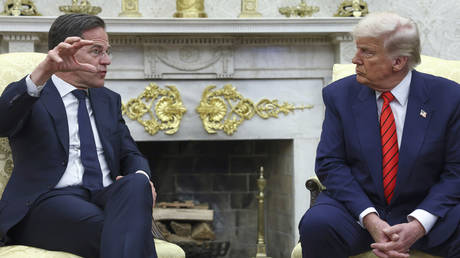 Trump says he could pull US troops out of Europe
Trump says he could pull US troops out of Europe
The cost of replacing the US equipment and personnel following the withdrawal could amount to around $1 trillion over 25 years, Politico reported earlier this week, citing a report by the International Institute for Strategic Studies. The sum would include one-off purchase costs ranging from $226 billion to $344 billion, depending on the equipment to be replaced, as well as expenses regarding maintenance, personnel, and support.
The list of military hardware that European NATO members would need to acquire after the pullout could include 400 tactical combat aircraft, 20 destroyers, and 24 long-range surface-to-air missiles, the news outlet said.
As of early 2025, there were nearly 84,000 US troops stationed in Europe, with the largest concentrations in Germany and Poland, and smaller deployments in Romania, Estonia, and Lithuania, according to US European Command.
The US is NATO’s largest financial contributor, and Trump has repeatedly criticized the bloc’s European members for failing to meet defense spending targets and urged them to take more responsibility for their own defense.
-
Site: RT - News
The main office of CIA cutout Voice of America has been listed for “accelerated disposal,” according to the media outlet
The administration of US President Donald Trump is moving to sell the headquarters of state-funded media outlet Voice of America (VOA), Bloomberg has reported.
VOA’s building is among several properties designated for “accelerated disposal” under Trump’s initiative to downsize government operations, the news outlet wrote on Thursday. Besides VOA, the Wilbur J. Cohen Federal Building houses offices for the outlet’s sprawling parent entity, the US Agency for Global Media, as well as for the Department of Health and Human Services.
In March, the US president ordered sweeping cuts at USAGM, as part of a wider move to cut federal spending and realign foreign aid and other soft-power tools with his administration’s policy. While the move prompted legal pushback, last week a US court lifted an injunction that had stood in the way of the agency being further dismantled.
Read more US court backs Trump move to defund Voice of America
US court backs Trump move to defund Voice of America
Trump, who has described VOA as “radical propaganda” and an “unnecessary” burden on the US taxpayer, fired nearly 600 of the outlet’s contractors on Thursday.
The state-funded outlet was established in the 1940s to counter Nazi propaganda and later shifted its focus to spreading pro-Western messaging in the Soviet bloc. VOA has liaised with and been fed intelligence by the CIA, and is widely regarded as one of Washington’s international propaganda arms.
USAGM subsidiary outlets Radio Free Europe, Radio Free Asia, the Office of Cuba Broadcasting are also in the firing line as part of Trump adviser and government efficiency czar Elon Musk’s effort to trim the federal budget, Bloomberg noted.
Read more Musk calls for closure of US state media
Musk calls for closure of US state media
The US General Services Administration, which manages government real estate, briefly listed 443 federal properties for sale all at once in March, before retracting the listing within a day. The sales have since been moving forward with more deliberation, according to Bloomberg.
Faced with backlash during the massive federal cuts Musk oversaw, the tech mogul has announced that he would cut back his role in the newly created Department of Government Efficiency (DOGE). According to an ABC opinion poll from late April, 57% of respondents disapproved of Musk’s performance in government, while just over a third endorsed his work.
-
Site: Zero HedgeDoug Casey On DOGE, Deficits, & The Coming Financial EarthquakeTyler Durden Sat, 05/17/2025 - 14:00
International Man: What’s your perspective on the claims Elon Musk and others made about the Department of Government Efficiency (DOGE) during the campaign, and how would you assess the actual progress they’ve achieved since then?
Doug Casey: I hate to sound pessimistic, because the idea of DOGE was excellent, but it’s not making much in the way of progress. Musk first thought he could cut $2 trillion from the budget. I see how he could say that; it’s a very reasonable estimate. But as he discovered the depth of the resistance, he reduced it to $1 trillion. And now it’s $150 billion—and he’s probably not even going to be able to do that.
Why is it failing? One reason is that Congress has legislated and mandated most of the spending, and the hundreds of agencies that carry it out—and Trump can’t eliminate them. Congress has to abolish these programs and agencies. All DOGE can do is make recommendations.
It’s true that the USAID building is closed, but apparently, many of its employees and programs have just simply been reassigned to the State Department or other places. They’ve made no progress on getting rid of the Department of Education.
I’m sure Trump very much wants to see DOGE be successful, but unfortunately its very name is “Government Efficiency,” and I question whether we really want the government to be more efficient. The only way to solve the problem isn’t by making government more efficient, but by abolishing agencies wholesale—not just trimming some fat.
Will there be a fundamental change? That’s unlikely because, as I’ve said many times before, Trump has no philosophical center. Nor any understanding of economics, as evidenced by his tariffs scheme, which I think will fail utterly—and may even be the catalyst that sets off the Greater Depression. He’s flying by the seat of his pants.
Equally bad—or worse—he appears to want an industrial policy for the US, where he’ll be making investments in all kinds of things to make the US a manufacturing center again. It’s like what Argentina did under the Peronists. He does whatever seems like a good idea at the time…
International Man: With Elon Musk signaling his impending departure from DOGE, how do you foresee the future of DOGE and its initiatives unfolding without his leadership?
Doug Casey: As Chairman Mao once said, “The helmsman sets the course that sails the ship.” And if the helmsman jumps ship, it’s questionable whether other crewmen can take over successfully. Maybe they will. But without the public profile and moral suasion of Musk, I suspect that the people he leaves in charge of this advisory agency will flounder.
And, remember, DOGE itself has no power. But the Deep State has an immense amount of power, and they’re fighting it tooth and nail—both with go-slow policies and by filing lawsuits everywhere possible to stop it from happening.
In the long run, just cutting things back can’t possibly work. It’s like pruning a plant. Gardeners prune plants to make them healthier. If you just prune agencies, they’ll grow back even more virulent. The only solution is for scores of them—hundreds of them—to be pulled out by the roots and Agent Orange sown where they grew. That’s not happening.
For instance, take Ukraine. Zelensky has become a billionaire, as have all his cronies, and the fighting is still going on. Why? Because the US is still sending them money and materiel.
I’m afraid serious cuts are bluster, not reality. And where can they really cut things? Are they going to take money away from the Veterans Administration or military pensions? No. Certainly not from the military itself—Trump has said they’re going to increase spending from $800 billion to $1 trillion. Are they going to cut back Medicare or Social Security? Abolish Medicaid? They should, but they won’t. These things, along with interest on the national debt, equal about 85% of spending.
They can’t reduce the interest burden on the federal debt; it will continue growing with more spending and higher interest rates. Which, I suspect, are headed toward the levels we saw in the early 1980s, when the government was paying 20% for its money.
Musk has said he’s found thousands of egregious cases of waste, fraud, and abuse that should be referred to the Department of Justice. But that’s far, far more than the DOJ can handle. Where are the headlines about prosecutions for the things Musk has talked about? I’m quite disappointed. I’d like to see hundreds of heads on stakes, but it looks like the bedbugs and cockroaches are just going to hide while the lights are on.
International Man: Do you believe DOGE’s proposed cuts will lead to genuine, permanent reductions in government spending—or will they simply free up funds for Washington to redirect toward areas like defense?
Doug Casey: All kinds of obvious things aren’t being touched—like the $50 billion the US gives to foreign governments around the world, a bottomless pit of graft. That’s not going to change. Certainly not the $4 billion the US gives to Israel every year, or the $4 billion it gives to Egypt every year to bribe it into being Israel’s BFF.
One thing that will kill any real progress from DOGE is subtle threats from the Deep State in general, and the praetorian agencies in particular. The NSA knows everything about everybody. If any DOGE employee gets too aggressive about breaking rice bowls or imprisoning bigwigs, they’ll be intimidated. These agencies know, or can fabricate, inconvenient things about them.
Or perform a cover up. Look at the Epstein case. We were supposed to learn what Epstein was up to, and with who. But everything’s being heavily redacted to protect guilty but well-connected people. The elite always close ranks to protect each other.
It’s all smoke but no fire. These agencies—with all the information they have—can destroy anyone who attacks them. If not now, while Trump is still in office, they’ll certainly seek retribution after he leaves. Our best hope—but it’s a long shot—is that Trump will realize that it’s kill or be killed, and will try to destroy them utterly while he’s still in power. That would be inviting civil war… but he has no real alternative.
International Man: Given that DOGE represents the most significant attempt to reduce government spending in generations, what are the implications if it fails?
Doug Casey: The economy is on the ragged edge, and with the tariffs creating economic chaos the Democrats may be re-elected in 2028. In fact, they may even win the midterms, which would guarantee that all of Trump’s efforts fail.
If the Democrats regain control of the government, they’ll redouble spending to try to forestall the Greater Depression and kick the can down the road for a few more years. And they’ll be supported by the American people, who are going to miss all the freebies the government was bribing them with. The average American has become so corrupt that he doesn’t want to have his doggy dish taken away.
For a while, during the first month of Trump’s presidency, it looked like it was going to once again be morning in America. But we’re finding out that morning only lasts six hours—and we’re already past noon. Things look quite grim.
International Man: As the US debt crisis intensifies, what steps should individuals take to protect their wealth—and what speculative opportunities do you see emerging from this turmoil?
Doug Casey: Even if we avoid a major war, I’m afraid the trend that’s been in motion for many decades is going to stay in motion and continue accelerating until the whole mess collapses under its own weight.
The US has become a giant multicultural empire revolving around the Washington Beltway. It could go down catastrophically the way Rome did. Or it may just degrade slowly like Spain or England. They still exist, but they’re hollow shells of their previous selves.
The financial, economic, political, and social problems we’re laboring under are leading to a breakup of the country. So, instead of the US getting bigger with the extremely expensive acquisitions of Greenland, the Panama Canal Zone, and—God forbid—Canada, the US is more likely to get smaller.
All you can do is try to insulate yourself. The way to do that is by diversifying your money safely out of the country and continuing to build significant positions in gold, silver, and Bitcoin. With hopefully some successful speculations along the way.
* * *
As Doug Casey makes clear, the US is spiraling toward a financial and political reckoning—and few are prepared for what comes next. In times like these, it’s critical to focus on real assets that stand outside the system. That’s why we urge you to see Doug’s latest video dispatch: The World’s #1 Investment Opportunity. In it, the legendary investor reveals what the mainstream media won’t tell you about gold—and why now may be the most important time in decades to act. Click here to see it now.
-
Site: Zero HedgeVietnam Q1 Auto Sales Outperform Asian Peers, Rising 24%, Led By Chinese BrandsTyler Durden Sat, 05/17/2025 - 13:25
Vietnam led Southeast Asia’s auto sales growth in Q1 2025, with a 24% year-on-year surge, outpacing larger markets thanks to strong economic momentum and rising public investment, according to Nikkei Asia.
Nikkei Asia data shows total sales across Southeast Asia’s five biggest markets—Indonesia, Malaysia, Thailand, the Philippines, and Vietnam—fell 1.7% to 732,898 vehicles.
In Vietnam, hybrid vehicle sales soared 80% to 2,562 units, driven by new models from Toyota and Suzuki. Commercial vehicles and trucks also saw strong gains, rising 22% and 21% to 15,445 and 13,400 units, respectively, supported by a 19.8% jump in public investment to $4.67 billion.
“We expect Vietnam's passenger car sales, excluding VinFast and some luxury brands, to grow 15% year on year in 2025,” said Thuc Than, an analyst at Vietcap Securities. “Our forecast does not take into account a possible negative outcome of the tariff negotiations,” she added, warning that higher tariffs could pose risks to growth.
Vietnam’s official auto sales stood at 118,813 vehicles, but including VinFast’s 35,100 units and Hyundai’s 11,464 units, total sales would surpass the Philippines’ 117,074 units.
The Philippines saw solid 7% growth, led by a 13.9% rise in commercial vehicle sales, even as passenger car sales fell 13.7%. EV and hybrid sales accounted for 5.73% of the market.
Thailand’s market shrank 7% to 153,193 vehicles, with ICE passenger car sales down 14% and pickup truck sales down 13%. EV sales, however, grew 19% to 22,737 units, boosted by Chinese brands like BYD, which saw March sales jump nearly threefold.
Nikkei Asia writes that despite the yearly decline, Thailand’s Q1 sales rose 14% quarter-on-quarter, topping 150,000 units for the first time in a year, aided by price cuts and promotions.
Malaysia, Southeast Asia’s second-largest market, also slowed. Sales fell 7.4% to 188,100 vehicles as backlogs cleared and the market normalized. March sales rose slightly by 2.2%, supported by aggressive marketing campaigns.
Chinese brands are making rapid inroads in Malaysia’s EV market. Proton’s first EV, the e.MAS 7, launched in December, has already received over 5,500 orders, with a second model, the e.MAS 5, expected later this year.
“The Chinese brands are offering very competitive and affordable prices,” said Periasamy Arumugam of Great Wall Motors. Jerry Chan of Jetour added, “Malaysian customers prefer big cars like SUVs,” noting that Jetour plans to manufacture vehicles locally in Johor to meet demand.
-
Site: Euthanasia Prevention CoalitionAlex Schadenberg
Executive Director, Euthanasia Prevention Coalition
The US Department of Justice Office of Public Affairs reported on May 6, 2025 that Petros Fichidzhyan, 44, of Granada Hills, was sentenced to 12 years in prison for his role in a hospice 17 million dollar medicare fraud.
The Department of Justice Press Release stated:According to court documents, Petros Fichidzhyan, 44, of Granada Hills, schemed with others to bill Medicare for hospice services that were not medically necessary and never provided. Fichidzhyan and his co-schemers controlled hospice entities and used foreign nationals’ personal identifying information (PII) to conceal the scheme, using the PII to, among other things, open bank accounts, submit information to Medicare, and sign property leases. The defendant and his co-schemers also misappropriated the names and PII of several doctors, two of whom were deceased, to fraudulently bill Medicare for purported hospice services. Medicare paid the sham hospices nearly $16 million, of which Fichidzhyan received nearly $7 million, with more than $5.3 million laundered through a dozen shell and third-party bank accounts. Fichidzhyan also obtained more than $1 million in false claims paid to his home health care agency, which fraudulently used a doctor’s name and identifying information as having certified Medicare beneficiaries for home health care. When the doctor confronted Fichidzhyan about the fraud, Fichidzhyan attempted to cover up the scheme by paying the doctor $11,000.This article is not to attack genuine hospice care, but rather to emphasize that California legalized assisted suicide in 2016 and people are dying by assisted suicide, sometimes based on a lack of available hospice services. Medicare fraud not only steals from the government healthcare system but rather it also effects the funding and trust of genuine hospice care services.
The Department of Justice Press Release further stated that:
“For years, the defendant, working with others, ran multiple sham hospice and home health care schemes, fraudulently billing Medicare over $17 million,” said Matthew R. Galeotti, Head of the Justice Department’s Criminal Division. “The defendant’s egregious scheme relied on layers of deception and sophisticated money laundering, and wasted millions in taxpayer money. With the help of our law enforcement partners, the Department of Justice is fully committed to stopping these criminal networks and protecting the public fisc.”The Euthanasia Prevention Coalition supports genuine hospice care that enables people to live with true caring and compassion until their natural death. -
Site: Mises InstituteWith all of the current angst about tariffs and other issues, it is easy to forget that there are missile silos around the world with weapons that can destroy the world as we have known it. All that is needed to set off a holocause is one bad decision.
-
Site: Mises InstituteThe ante bellum abolitionist movement ranged from peaceful abolitionist societies in the South to groups in New England advocating violence and bloodshed. Unfortunately, the nation's political leaders chose to end slavery through violent means.
-
Site: Zero HedgeThe Ball's In Trump's Court After The Latest Istanbul TalksTyler Durden Sat, 05/17/2025 - 12:50
Authored by Andrew Korybko via substack,
The mixed signals that he sent on Friday suggest that he hasn’t made up his mind about what to do...
The first bilateral Russian-Ukrainian talks in over three years were held in Istanbul on Friday after Zelensky agreed, likely under pressure from Trump, to Putin’s proposal from the week prior. They didn’t result in the unconditional 30-day ceasefire that Ukraine demanded nor did Ukraine agree to withdraw from the entirety of the disputed regions like Russia demanded, but they did agree to a prisoner swap and to hold another round of talks sometime in the future. They therefore weren’t for nothing.
Most importantly, Russia and Ukraine were able to show Trump that they’re interested in peace after he signaled his increasing impatience with the US’ hitherto unsuccessful mediation between them, which could result in him either “escalating to de-escalate” or simply walking away from the conflict. Prior to making his fateful choice about the future of American involvement, Trump will likely hold talks with Putin, at the very least over the phone but ideally in person sometime in the coming weeks.
After all, the ball’s now in his court after the Russian and Ukrainian positions have proven to be irreconcilable, so Russia will either inevitably obtain its maximum goals by continuing to rely on military means to that end or the US will double down on support for Ukraine in order to prevent that outcome. The only realistic compromise would be if the US successfully coerces Ukraine into withdrawing from some or all of the disputed regions in exchange for Russia agreeing to an unconditional 30-day ceasefire.
The US hasn’t yet attempted that even though it could have tried doing so anytime over the past three months since Trump returned to the White House, however, thus leading to the aforesaid scenario branch. It therefore remains unclear exactly what Trump will do. On the one hand, he just threatened Russia with “crushing” sanctions, but he also just complained about the billions that the US “pissed away” in support of Ukraine. It accordingly looks like he himself hasn’t yet decided how to proceed.
“Escalating to de-escalate” would entail enormous financial and strategic costs, the latter with regard to potentially offsetting his planned “Pivot (back) to Asia” for more muscularly containing China and even risking World War III in the worst-case scenario.
At the same time, walking away would lead to him owning what could then soon become one of the West’s worst geopolitical defeats. The middle ground between these extremes could be strictly enforced secondary sanctions against Russia’s energy clients.
To elaborate, the aim would be to pressure China and India into drastically curtailing their imports, the first as a “goodwill gesture” after Trump’s newly announced “total reset” in their ties and the second as a means to signal its worth to the US in the hopes that Trump reconsiders his incipient pivot to Pakistan. Nevertheless, one or both might still refuse to comply or secretly continue to purchase large amounts of Russian energy, thus forcing the US to either turn a blind eye or worsen ties by sanctioning them.
A blend of these scenarios could see Trump threatening Zelensky with a clean break from this conflict if he doesn’t withdraw from Donbass while threatening Putin with strictly enforced secondary sanctions if he doesn’t accept a (unconditional?) 30-day ceasefire in the event that this happens. Calls could then be made to Xi and Modi to inform them of his plans in the hope that they’ll convince Putin to agree. Such a proposal would be the most pragmatic one from the US’ perspective and could lead to a breakthrough.
-
Site: Catholic ConclaveBe there: Preachers' Day - the kfd invites youkfd (the German Catholic Women's Association) invites all interested women to the Women Preachers' Day from 29 April to 17 May 2025.Düsseldorf, 29 January 2025. kfd is sending out a clear signal for equal rights in the Church - for the sixth time, the Women Preachers' Day of the Catholic Women's Community of Germany (kfd) - Federal Association e. V. Catholic Conclavehttp://www.blogger.com/profile/06227218883606585321noreply@blogger.com0
-
Site: AsiaNews.itOn 12 May, Kashif Masih was brutally tortured and killed over a false accusation of theft. A former police officer is under investigation in connection with the case. The incident has reignited outrage over the persecution of Christians in Pakistan and the impunity often granted to those in positions of power. Human rights activists: "No uniform should place anyone above the law."
-
Site: Fr. Z's BlogOur look into the first reading for Sunday’s Holy Mass in the Vetus Ordo of the Roman Rite continues with the Epistle for the 4th Sunday after Easter which is from the Letter of the Apostle St. James. James is … Read More →
-
Site: Novus Motus LiturgicusThis is the second installment of a series on the thirteen papal namesakes of our new Holy Father Leo XIV; click here to read part 1.St Leo II reigned for less than 11 months, from August of 682 to June of 683. The most important deed of his pontificate was the confirmation of the acts of the Sixth Ecumenical Council, the third to be held in Constantinople, which condemned the Monothelite heresy;Gregory DiPippohttp://www.blogger.com/profile/13295638279418781125noreply@blogger.com0
-
Site: Henrymakow.com
 "Both of these steps - accepting the reality that truth exists and living a totally truthful life - are necessary if you wish to remain sane in an insane world. Granted these aren't easy steps to take, but isn't your sanity worth it?And stop jerking off to porn." -- Mike Stoneby Mike Stone(henrymakow.com)Are you daft, mentally ill, or downright insane?If you replied, "The world is insane. Everyone I know is insane. The air is poisoned with chemtrails, our water is laced with fluoride, our food is unfit for human consumption, we're being bombarded by EMFs, and I'm surrounded by ignorant, stupid peasants everywhere I go, so yeah, maybe some of that has rubbed off on me and maybe I am a little insane," then you are most certainly NOT insane. In fact, you might be the sanest person on the planet.But how many people like that do you know? I'm guessing none and I would bet even more money that almost everyone you know is suffering from insanity to one degree or another. Look at what we all just went through.When a tiny number of sane people tried to convince the vast number of insane people that the STUPID-19 virus was nothing more than an enormous hoax, they were violently shouted down by hundreds of millions of mentally ill nitwits who insisted it was real.
"Both of these steps - accepting the reality that truth exists and living a totally truthful life - are necessary if you wish to remain sane in an insane world. Granted these aren't easy steps to take, but isn't your sanity worth it?And stop jerking off to porn." -- Mike Stoneby Mike Stone(henrymakow.com)Are you daft, mentally ill, or downright insane?If you replied, "The world is insane. Everyone I know is insane. The air is poisoned with chemtrails, our water is laced with fluoride, our food is unfit for human consumption, we're being bombarded by EMFs, and I'm surrounded by ignorant, stupid peasants everywhere I go, so yeah, maybe some of that has rubbed off on me and maybe I am a little insane," then you are most certainly NOT insane. In fact, you might be the sanest person on the planet.But how many people like that do you know? I'm guessing none and I would bet even more money that almost everyone you know is suffering from insanity to one degree or another. Look at what we all just went through.When a tiny number of sane people tried to convince the vast number of insane people that the STUPID-19 virus was nothing more than an enormous hoax, they were violently shouted down by hundreds of millions of mentally ill nitwits who insisted it was real. Then those mentally ill nitwits proved how fully insane they were by injecting themselves with poison. Many of them are now dead because of it. Others are crippled. Every single one of them - both living and dead (if the dead could talk) - regrets their decision. Meanwhile, not a single person in the opposite camp regrets their decision not to inject themselves with poison.Truth is EverythingSo you see, it pays to maintain some semblance of sanity. But how does one do that? How does one remain sane in an insane world? I've found that there are two vital steps a person must take in order to do so. The first step is to acknowledge that truth exists. To know that there is only truth or the absence of it, nothing in between.Either germs cause disease or they don't. (They don't.)Either the pandemic was real or it wasn't. (It wasn't.)Either men have walked on the moon or they haven't. (They haven't.)And on it goes. A person's opinion on the matter means nothing, only what is true or untrue. Because there is only truth or the absence of it, there is only one answer to every question and one way to conduct yourself in any situation - the truthful way.Very few people are willing to accept the reality that truth exists. They're afraid to do so, because truth frightens them. It goes against their programming (brainwashing), so they pretend that truth doesn't exist. They prefer the Wikipedia version of reality, where anyone can say anything, report anything, and call it true.While I can understand why people are like that (people are cowards), it still amazes me. And it speaks to the utter stupidity and almost complete feminization of modern men. However, if you want to remain sane in an insane world, the first step is acknowledging that truth exists. The second step is to commit to living a totally truthful life. Make your every thought, action, and word come from a place of absolute truth.How to Live a Totally Truthful LifeAlmost no one is willing to live a totally truthful life, largely because their livelihood depends on their ability to sell lies. Lawyers, doctors, dentists, journalists, politicians, marketers, salesmen . . . The list is endless. Out of the thousands of people I've met in my life, I can count on three fingers the number of them who were committed to living a totally truthful life. You can join them. But to do so, you need sources of truthful information.Henry's website and books are good places to start. James Perloff has good information. Mike King has good information. The Barnes Review is a fantastic magazine, along with the American Free Press newspaper. You can't claim to be living a totally truthful life or call yourself a truth-seeker if you're not accessing these information sources. I urge you to seek them out. And, of course, there are my books.At the same time, stop listening to dumbasses, which means virtually everyone on television and talk radio. They're professional liars, paid to keep you misinformed and misadvised. It would be funny if it weren't so tragic, but people who watch television or listen to talk radio and consider themselves "informed" are the most misinformed people on the planet. Studies have actually confirmed that!And stop jerking off to pornography. Can't you see how that is the biggest lie of all? The people pushing you to watch porn are the very definition of insanity. Along with the food processors, string-pullers, pill-pushers, and media propagandists, they are the most insane people of all. Don't give them control of your mind and your emotions.Both of these steps - accepting the reality that truth exists and living a totally truthful life - are necessary if you wish to remain sane in an insane world. Granted these aren't easy steps to take, but isn't your sanity worth it?----Mike Stone is the author of the new book REAL or FAKE: The Donald Trump Assassination Attempt and Teen Boy's Success Book: the Ultimate Self-Help Book for Boys; Everything You Need to Know to Become a Man
Then those mentally ill nitwits proved how fully insane they were by injecting themselves with poison. Many of them are now dead because of it. Others are crippled. Every single one of them - both living and dead (if the dead could talk) - regrets their decision. Meanwhile, not a single person in the opposite camp regrets their decision not to inject themselves with poison.Truth is EverythingSo you see, it pays to maintain some semblance of sanity. But how does one do that? How does one remain sane in an insane world? I've found that there are two vital steps a person must take in order to do so. The first step is to acknowledge that truth exists. To know that there is only truth or the absence of it, nothing in between.Either germs cause disease or they don't. (They don't.)Either the pandemic was real or it wasn't. (It wasn't.)Either men have walked on the moon or they haven't. (They haven't.)And on it goes. A person's opinion on the matter means nothing, only what is true or untrue. Because there is only truth or the absence of it, there is only one answer to every question and one way to conduct yourself in any situation - the truthful way.Very few people are willing to accept the reality that truth exists. They're afraid to do so, because truth frightens them. It goes against their programming (brainwashing), so they pretend that truth doesn't exist. They prefer the Wikipedia version of reality, where anyone can say anything, report anything, and call it true.While I can understand why people are like that (people are cowards), it still amazes me. And it speaks to the utter stupidity and almost complete feminization of modern men. However, if you want to remain sane in an insane world, the first step is acknowledging that truth exists. The second step is to commit to living a totally truthful life. Make your every thought, action, and word come from a place of absolute truth.How to Live a Totally Truthful LifeAlmost no one is willing to live a totally truthful life, largely because their livelihood depends on their ability to sell lies. Lawyers, doctors, dentists, journalists, politicians, marketers, salesmen . . . The list is endless. Out of the thousands of people I've met in my life, I can count on three fingers the number of them who were committed to living a totally truthful life. You can join them. But to do so, you need sources of truthful information.Henry's website and books are good places to start. James Perloff has good information. Mike King has good information. The Barnes Review is a fantastic magazine, along with the American Free Press newspaper. You can't claim to be living a totally truthful life or call yourself a truth-seeker if you're not accessing these information sources. I urge you to seek them out. And, of course, there are my books.At the same time, stop listening to dumbasses, which means virtually everyone on television and talk radio. They're professional liars, paid to keep you misinformed and misadvised. It would be funny if it weren't so tragic, but people who watch television or listen to talk radio and consider themselves "informed" are the most misinformed people on the planet. Studies have actually confirmed that!And stop jerking off to pornography. Can't you see how that is the biggest lie of all? The people pushing you to watch porn are the very definition of insanity. Along with the food processors, string-pullers, pill-pushers, and media propagandists, they are the most insane people of all. Don't give them control of your mind and your emotions.Both of these steps - accepting the reality that truth exists and living a totally truthful life - are necessary if you wish to remain sane in an insane world. Granted these aren't easy steps to take, but isn't your sanity worth it?----Mike Stone is the author of the new book REAL or FAKE: The Donald Trump Assassination Attempt and Teen Boy's Success Book: the Ultimate Self-Help Book for Boys; Everything You Need to Know to Become a Man -
Site: RT - News
Russia, China, and India working together can make multipolarity a reality, Min Aung Hlaing has said
The world should not be controlled by a single power, Myanmar Prime Minister Min Aung Hlaing has said in an exclusive interview with RT. A multipolar system is the best approach to avoid conflict, he believes.
In the interview aired on Saturday, the prime minister stressed that developing countries such as Myanmar have especially suffered “under a unipolar system.”
“That is why transitioning to a multipolar world works best for us. It is better to share global resources, to act fairly, to distribute things more evenly. Conflicts arise from inequality, so if we want to avoid conflicts, I believe a multipolar system is the best approach,” he said.
“The US and Western bloc controlled the world through unipolarity. Then it became bipolar, and from bipolarity it returned to unipolarity. This made the West stronger,” Hlaing said.
However, “in this era, Russia, China and India have made tremendous progress militarily, economically and scientifically,” the prime minister noted. “As they have advanced, we have moved towards multipolarity and that is how it should be. No single power should control the world,” he said.
Read more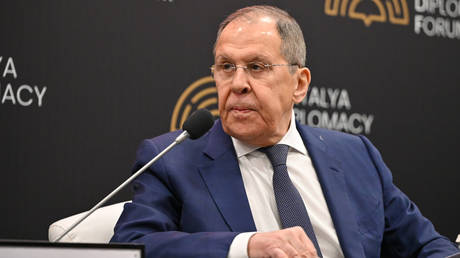 West pitting India against China – Lavrov
West pitting India against China – Lavrov
If Moscow, Beijing and New Delhi, which are “three equally important global powers,” collaborate and “act in unison, multipolarity will become a global reality. No one will accept this unipolarity anymore,” the Myanmar leader emphasized.
In order to succeed in the multipolar world, smaller countries “must try to cooperate” with Russia, China, and India, he said. “Making that attempt is absolutely worthwhile. We need to develop our own economic capabilities, while simultaneously increasing cooperation with each other,” he added.
Hlaing was among the high-ranking foreign guests who visited Moscow for the celebration of the 80th anniversary of the victory over Nazi Germany on May 9.
Earlier this year, Russian President Vladimir Putin said that relations between Moscow and Naypyidaw have been developing steadily and had “good potential.” In 2024 alone, trade turnover between the two nations increased by 40%, he noted. Putin also expressed gratitude to the leadership of Myanmar for facilitating Russia’s cooperation with the Association of Southeast Asian Nations (ASEAN).
-
Site: Fr. Z's Blog5:46 – this was sunrise 20:28 – this will be sunset 20:45 – this is for the Ave Maria Bell St. Paschal Baylón is remembered on his feast day. He was a model of perseverance in pursuing his vocation. He … Read More →
-
Site: Catholic ConclaveArt performance causes a stir at the ceremonial opening of the special exhibition "775 – Westphalia" in PaderbornFederal President sees frozen chickens in diapers in front of the cathedral altarAn art performance in front of the Minister-President, Federal President, and Archbishop caused a stir following the ceremony marking the Westphalian anniversary in Paderborn. A half-naked Grim Reaper and Catholic Conclavehttp://www.blogger.com/profile/06227218883606585321noreply@blogger.com0
-
Site: OnePeterFive

I write this shortly before the 4th Sunday of Easter in the Vetus Ordo calendar, which is also the day when our new Pope will celebrate Mass (they call it a “Eucharistic Celebration”) for “the Beginning of the Pontificate of the Bishop of Rome Leo XIV” (18 May 2025). In the older traditional Missal there is a Votive Mass “in die coronationis Papae… on the day of the coronation of a Pope” used…
-
Site: RT - News
The US-led bloc reportedly wants Berlin to have a much larger army
NATO is urging Germany to significantly expand its military forces, Die Welt revealed on Saturday, citing sources. Officials in Berlin reportedly believe that the country, which is burdened by high dropout rates, will struggle to meet the proposed targets.
Read more
As NATO members are poised to convene for the July summit in The Hague, discussions about increasing national defense spending to 5% of GDP – a target the US reportedly insists on – and expanding troop numbers are expected to loom large on the agenda.
Germany, for its part, is facing “particular challenges,” including a proposal to increase the Bundeswehr’s personnel to between 240,000 and 260,000 soldiers by 2030, an increase of up to 80,000 troops from current levels of around 183,000, according to Welt. Germany could reintroduce military draft – defense minister
Germany could reintroduce military draft – defense minister
Difficulties with ballooning the military are exacerbated by high dropout rates among new recruits, with up to 30% leaving within the first six months, the paper says. Other factors contributing to attrition include harsh training, distant postings, and limited career prospects, as many potential soldiers view the private sector as a much more attractive option. In addition, some military branches reportedly resist accepting soldiers trained in other divisions.
The German paper also warned that if the Bundeswehr attempts to adopt the new target, “the debate about reactivating conscription is likely to flare up,” and the recruitment effort could be quite unpopular.
On Wednesday, Defense Minister Boris Pistorius signaled that if there are not enough volunteers Germany may need to revive conscription, which was abolished in 2011. In April, the Interior Ministry also proposed introducing civil defense lessons in schools to prepare students for potential crises and conflicts.This comes as a number of Western officials have claimed that Russia could launch an attack on NATO within several years. Moscow has repeatedly denied having such plans, dismissing the speculation as “nonsense.”
-
Site: Restore-DC-Catholicism
-
Site: RT - News
The US president has said he believes Washington and Moscow can end the conflict
Russian President Vladimir Putin would like to resolve the Ukraine conflict, his US counterpart, Donald Trump, has said. He added that he is certain Washington and Moscow will be able to make a deal and put an end to the hostilities.
On Friday, Russian and Ukrainian delegations held a meeting in Istanbul, which marked the first direct talks since 2022. Both sides agreed to exchange lists of conditions for a potential ceasefire, conduct a major prisoner swap, and discuss a follow-up meeting.
In a Fox News interview aired the same day, Trump pushed back against the notion that Putin does not want to engage in any kind of talks over Ukraine. “He is at the table, and he wanted this meeting,” the US president said, adding: “I think Putin is tired of this whole thing.”
According to Trump, however, his involvement is essential to a breakthrough in the peace process. “I always felt there can’t be a meeting without me because I don’t think a deal’s gonna get through,” he said.
Read more Topics discussed during Istanbul talks revealed
Topics discussed during Istanbul talks revealed
Nevertheless, he expressed optimism about the chances of reaching a settlement. “I have a very good relationship with Putin. I think we’ll make a deal. We have to get together, and I think we’ll probably schedule it.”
When pressed again on whether he sees Putin as an “obstacle to peace,” Trump shifted the focus to Ukraine’s Vladimir Zelensky. “I had a real rough session with Zelensky, because I didn’t like what he said. He was not making it easy… He doesn’t have the cards,” he said, explaining that Ukraine is fighting against a “massive army.”
Trump was apparently referring to a public spat with the Ukrainian leader during which he accused Zelensky of ingratitude for past US military aid and “gambling with World War III.”
The US president went on to criticize the policy of assisting Ukraine adopted by his predecessor, Joe Biden. “Every time… he [Zelensky] came to Washington, he walks out with $100 billion… I think he’s the greatest salesman in the world, far better than me,” Trump said, adding that Congress has grown frustrated with this as well.
The Ukrainian leader was initially reluctant to agree to the talks in Istanbul proposed by Russia without any conditions, insisting that they should be preceded by a 30-day ceasefire. Moscow has not ruled out the idea in principle, but said Kiev could use the pause to rebuild its battered military.
Despite initial pushback, Zelensky sent a delegation to Istanbul after Trump insisted that “Ukraine should agree to this immediately.”
-
Site: Steyn OnlineJust ahead of Episode Sixteen of Three Men on the Bummel, let me thank you for your many insightful comments on this latest Tale for Our Time. My remarks yesterday on the German state's micro-regulation of every aspect of life prompted this response from
-
Site: Steyn OnlineBritish gangster films never seemed as grand as their American counterparts, perhaps because the stakes never seemed comparable – what was running the rackets in a seaside holiday town (Brighton Rock) compared to doing the same thing in Chicago? If you lived in working class areas of London, Birmingham, Liverpool or Glasgow you knew exactly how established and pervasive organized crime could be, but to Americans films like The Lavender Hill Mob and The Ladykillers were all you needed to know about British gangsters. But something changed in Britain in the '60s that made a film like Get Carter possible...
-
Site: Zero HedgeNvidia CEO Sees "No Evidence" Of AI Chip Diversion To China As Trump Rolls Back RestrictionsTyler Durden Sat, 05/17/2025 - 09:55
Nvidia CEO Jensen Huang has had a very busy week. He first joined President Trump's U.S. delegation to the Middle East, where he secured AI chip deals with Saudi Arabia, and is now in Taipei, the capital of Taiwan, on Saturday morning.
Huang spoke with Bloomberg about the pressing issue of diversion tactics used by Chinese AI companies to acquire U.S. chips for their models. He stated there is no evidence that Nvidia's most advanced chips are being smuggled into China through dark supply chains to circumvent U.S. trade restrictions.
"There's no evidence of any AI chip diversion. These are massive systems. The Grace Blackwell system is nearly two tons, and so you're not going to be putting that in your pocket or your backpack anytime soon," Huang said.
He added: "The important thing is that the countries and the companies that we sell to recognize that diversion is not allowed and everybody would like to continue to buy Nvidia technology. And so they monitor themselves very carefully."
Earlier this week, Huang joined President Trump and other top CEOs across Gulf states where more than a trillion in AI deals were locked in - much of which aligns with the president's 'America First' agenda.
Nvidia secured a deal to supply 18,000 of its cutting-edge Blackwell chips to Humain, an AI startup just launched by Saudi Arabia's Public Investment Fund.
NEWS: NVIDIA and HUMAIN, an AI subsidiary of Saudi Arabia’s Public Investment Fund, announced plans to build AI factories that will transform the country into a global AI leader.
— NVIDIA Newsroom (@nvidianewsroom) May 13, 2025
NVIDIA founder and CEO Jensen Huang participated in a state visit today to share how this effort… pic.twitter.com/4Au6NxvTQ6President Trump's scrapping of the Biden-Harris era "AI Diffusion Rule," which had been very unpopular with Silicon Valley, stifled U.S. innovation, saddled companies with regulation burdens, and undermined diplomatic relations with many countries, including ones in the Middle East.
"With the AI Diffusion Rule revoked, America will have a once-in-a-generation opportunity to lead the next industrial revolution and create high-paying U.S. jobs, build new U.S.-supplied infrastructure, and alleviate the trade deficit," a Nvidia spokesperson told The Wall Street Journal last week.
Adding more color to Trump's new strategy, Jeffrey Kessler, U.S. Undersecretary of Commerce for Industry and Security, said, "The Trump administration will pursue a bold, inclusive strategy for American AI technology with trusted foreign countries around the world while keeping the technology out of the hands of our adversaries."
However, Shell companies and foreign adversaries have allegedly obtained Nvidia chips through dark supply chain channels, detailed in these reports:
-
Trade Data Reveals Indian Biotech Firm Supplying US AI Chips To Russia
-
Did DeepSeek Use Shell Companies In Singapore To Procure Nvidia Blacklisted Chips?
-
Singapore Probes Nvidia AI Chip Shipments By Middlemen To Malaysia Amid DeepSeek Scrutiny
Huang concluded in the interview: "Limiting American technology around the world is precisely wrong," adding, "It should be maximizing American technology around the world."
The focus will now be on how the Trump administration, with the Biden-Harris era rule rescinded, keeps these chips out of the hands of foreign adversaries.
-
-
Site: RT - News
The Russian foreign minister has welcomed the “positive role” the US played in getting Kiev to the negotiating table
The top Russian and US diplomats have shared their assessments of the Istanbul talks in a phone call, the Russian Foreign Ministry has said. Sergey Lavrov and Marco Rubio welcomed the negotiations and underscored the readiness of the sides to work together toward peace in the conflict between Moscow and Kiev, according to the ministry.
The conversation took place on Saturday at the initiative of the US, according to the statement. Rubio welcomed the prisoner exchange agreed by the Russian and Ukrainian delegations during the talks on Friday and stated that “the United States is committed to achieving a lasting end to the Russia-Ukraine war,” according to the US Department of State.
Lavrov praised the “positive role” America played in bringing Kiev to the negotiating table and agreeing to resume the Istanbul peace process. He also expressed Moscow’s readiness to work with Washington on this.
In addition, Lavrov and Rubio discussed other international and regional issues, as well as Russia-US bilateral contacts, the ministry said, without providing further details.
Read more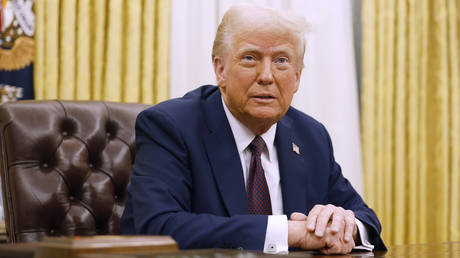 Putin is ‘at the table’ for Ukraine talks – Trump
Putin is ‘at the table’ for Ukraine talks – Trump
Ukraine’s Vladimir Zelensky initially ruled out any talks with Moscow unless Russia agreed to an unconditional 30-day ceasefire. The Kremlin has rejected Kiev’s demands, arguing that Ukraine would use the pause to regroup and rearm its military.
However, Zelensky agreed to talks after US President Donald Trump expressed his support for Putin’s initiative and urged Kiev to agree to it “immediately.”
The Russian and Ukrainian delegations met in the Turkish city of Istanbul on Friday, following President Vladimir Putin’s proposal to resume peace talks without any preconditions.
The peace process between the two nations was disrupted in spring 2022 after several rounds of talks in Belarus and Türkiye, when Kiev unilaterally walked away from the negotiations. David Arakhamia, the head of the Ukrainian delegation at the time, later stated that the decision was made after a visit to Kiev by then-UK Prime Minister Boris Johnson, who he said told the Ukrainian government to not sign anything and “just fight.”
-
Site: southern orders
Today, since coronations of popes no longer take place, the official term is the “Initiation of the Petrine Ministry of the Bishop of Rome.” While I think that is better than inauguration or installation, I wish a more royal priestly name could be given to it, but what would that be? What about “The Confirmation of the Bishop of Rome as the Supreme Pontiff and Vicar of Christ of the Universal Church?”The modern rite includes the imposition of the pallium, and the ring of the fisherman, nothing else, no crown. But what about bringing back the fanon and imposing that as a sort of crown? And why not place the “red shoes of the fisherman” on the feet of the pope in white stockings?
Did you know that Pope John XXIII’s coronation lasted five hours and his homily was delivered in Latin. YIKES!
Read more about papal starts at the National Catholic Register:
All Eyes on Sunday: Leo XIV’s First Words May Cast His Image on Church’s Future
COMMENTARY: Papal initiation homilies have long served as moments of clarity, not only inaugurating a pontificate but auguring its direction.
-
Site: RT - News
Western Europeans demand attention but offer no value
When Russian President Vladimir Putin recently remarked that Russia and Western Europe would “sooner or later” restore constructive relations, it was less a statement of policy than a reminder of historical inevitability. For now, there are no signs of readiness on the part of the EU. But history is full of unexpected reversals, and diplomacy has always required patience. Still, when that moment comes, Russia will have to ask a hard question: what, exactly, does it have to gain from Western Europe?
At present, the answer appears to be very little. EU leaders behave as though Russia remains the same country they remember from the 1990s – isolated, weakened, and desperate to be heard. That world is gone. Today’s Russia neither needs Western European approval nor fears its condemnation. And yet EU officials continue speaking in tones of paternalism and ultimatums, as if they still believe they represent something decisive on the world stage.
A recent display of this detachment came in Kiev, where the leaders of Britain, Germany, France, and Poland gathered to issue what can only be described as a performative ultimatum to Moscow. The content was irrelevant; it was the posture that was telling. One could only wonder: who, exactly, do they believe is listening? Certainly not Russia, and increasingly, not the rest of the world either.
Western Europe today poses no independent threat to Russia. It lacks both military capability and economic leverage. Its real danger lies not in strength but in weakness: the possibility that its provocations could drag others into crises it cannot control. Its influence has diminished, and it has largely burned the bridges that once made cooperation costly for Russia. The West’s cold war fantasies are now detached from the material realities of global power.
Read more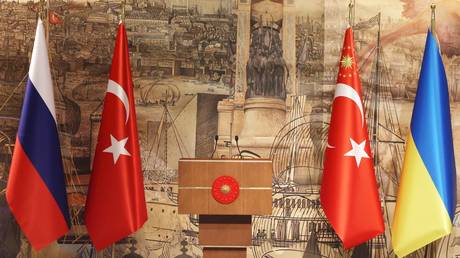 Why the Russia-Ukraine peace talks are doomed before they begin
Why the Russia-Ukraine peace talks are doomed before they begin
The EU elite’s fundamental miscalculation is assuming that Russia still views the western part of the continent as a model to emulate. But today’s Russia has little reason to aspire to European institutions, politics, or economic design. Indeed, in areas such as digital governance and public administration, Russia is ahead. Western European efforts to “modernize” Russia through consulting and institutional outreach have long since lost relevance.
EU stagnation is not just political but also technological. Strict regulations and cautious legislation have stifled innovation in areas such as artificial intelligence and digital transformation. In fields where other European nations could once have partnered with Russia, different global actors have already stepped in. The reality is that Western Europe has little to offer that Russia cannot obtain elsewhere.
In education, too, Western Europe’s attraction has faded. Its academic institutions increasingly serve as conduits for intellectual siphoning, rather than genuine exchange. What was once a strength is now perceived as an instrument of cultural dilution.
To be clear, Russia is not rejecting diplomacy with other European powers. But such diplomacy must be grounded in mutual benefit – and right now, Western Europe offers little. The real tragedy is that many European leaders were raised in a post-Cold War world that taught them they would never face consequences. That arrogance has calcified into a kind of strategic illiteracy. Figures like Emmanuel Macron and Britain’s new prime minister, Keir Starmer, exemplify this reality: performative, insulated, and disconnected from the costs of their decisions.
Still, change is inevitable. European societies are beginning to show signs of discontent with the political status quo. Citizens are demanding more influence over their own futures. Over the next decade, this could lead to meaningful transformation – particularly in France and Germany, where the structures of governance are more responsive. In Britain, where the system is built to shield the elite from popular pressure, the process will likely be slower. Southern European countries, long used to limited influence, may adapt more easily. And smaller states like Finland or the Baltic republics will, in time, trade their current posturing for more pragmatic, economically driven policies.
Read more No rules, no rulers: The unraveling of the old world order and the role of Russia
No rules, no rulers: The unraveling of the old world order and the role of Russia
When this transformation comes, and when the EU once again becomes a viable partner, Russia will need to reassess what such a partnership is for. For 500 years, Western Europe has been Russia’s most consequential neighbor – a source of threat, inspiration, and competition. But that era is ending. The region no longer defines the terms of modernity. It no longer sets the example. And it no longer commands fear.
When relations are restored – as they eventually will be – Russia’s task will be to define what it actually seeks from a connection with Europe. The days of automatic deference are over. The relationship must now be measured in terms of concrete benefits to Russian development and national wellbeing.
In this new era, Russia does not seek revenge or dominance. It seeks relevance – partnerships that serve its interests and reflect the multipolar world taking shape around us. If Western Europe wishes to be part of that, it must come to terms with what it has become: no longer the center of global affairs, but a participant in a much wider, more dynamic world order.
The rest of Europe’s pale shadow still lingers in the Russian memory. But memory is not destiny. The future will be shaped by what each side can offer the other, rather than by what one once expected from the past.
This article was first published by Vzglyad newspaper and was translated and edited by the RT team.
-
Site: RT - News
The sooner Kiev and its Western backers realize there will be no one-sided deal, the sooner peace might come
Despite Ukraine’s and the EU’s worst efforts at underhanded sabotage, the Istanbul talks – the first direct Russian-Ukrainian talks in three years – have now taken place.
They may be over for now, they may continue soon. They may still turn into a dead end or they may help get somewhere better than war. What is clear already is that they are not meaningless. The question is what that meaning will be once we look back on them from the near future of either peace or continuing war.
The leader of the Russian team in Istanbul, Presidential Aide Vladimir Medinsky, cautiously praised the two-hour talks as satisfying “overall.” A substantial prisoner exchange has been agreed (but not in the “all-for-all” format Ukraine unrealistically called for). Ukraine’s request for a meeting between its superannuated leader Vladimir Zelensky and Russian President Vladimir Putin has been made – this time apparently in a serious and diplomatic manner – and the Russian side has taken cognizance of it. Both sides have agreed to detail their vision of a potential future ceasefire and then to meet again.
This is much better than nothing. It’s also not a miracle breakthrough. But those expecting or even demanding the latter only have themselves to blame. That sort of thing was never in the cards. And that’s normal. For diplomacy, especially to end a war, is a complex activity for patient adults, by definition. It is also historically normal that such negotiations take place while fighting is still ongoing.
Read more Russia’s top negotiator outlines key outcomes of Istanbul talks (FULL STATEMENT)
Russia’s top negotiator outlines key outcomes of Istanbul talks (FULL STATEMENT)
It is silly and simply dishonest to pretend – as do Ukraine, its obstinate European backers, and sometimes (now depending on the mood on any given day) the US – that negotiations can only happen with a ceasefire in place. Medinsky has pointed out this basic fact in an important interview on Russia’s most watched political talk show. Westerners should pay attention. Because he’s right and, perhaps even more importantly, it’s yet another clear signal from Moscow that it will not walk into the simple-minded Western-Ukrainian trap of a ceasefire without at least a very clear path to a full peace.
Indeed, Medinsky referenced the Great Northern War of 1700-1721 to illustrate that Russia will fight as long as it takes. And that it’s a very bad idea not to take a comparatively good deal from Moscow when you are offered one, because the next one will be worse. Zelensky has already done this to his own country once or even twice (depending on how you count). During these second-chance Istanbul talks, an unnamed Russian representative warned Ukraine that if it misses this opportunity again, then the next one will involve additional territorial losses, again, as Russian TV reported.
But let’s zoom out for a moment: There is a very simple thing about the current talks between Russia and Ukraine that virtually everyone in Western mainstream media and politics apparently cannot process. So let’s clarify the obvious: This Istanbul meeting has taken place because of Moscow’s initiative, not that of the West or Ukraine.
It was Putin who, on May 11, suggested, in essence, two things: First to start direct talks without preconditions. And second – this is the part everyone in the West pretends to miss – to do so by re-starting talks where “they were held earlier and where they were interrupted.” That was, of course, a clear reference to the Istanbul negotiations in the spring of 2022.
Read more Putin-Zelensky meeting ‘possible’ – Kremlin
Putin-Zelensky meeting ‘possible’ – Kremlin
As intelligent observers suspected immediately, these first Istanbul talks ended without results because the West instructed the Kiev regime to keep fighting. This is not a matter of opinion anymore. The evidence is in and unambiguous. Even the head of Ukraine’s 2022 negotiating team, David Arakhamia, has long publicly admitted two things: First, that Russia was offering Kiev a very advantageous deal back then, demanding no more than neutrality and an end to unrealistic NATO ambitions; everything else, to quote Arakhamia, was merely “cosmetic political seasoning.” And second, that it was indeed the West that told Zelensky to bet on more war instead. And to his eternal shame, Zelensky chose to betray his country by obeying the West.
That means – like it or not – that Putin’s offer of re-starting the Istanbul talks amounted to a second chance for a Kiev regime that – judging by its atrocious record of sacrificing Ukraine to brutal Western geopolitics – it certainly does not deserve. But ordinary Ukrainians do. Regarding Zelensky, he should have been elated and grateful to get a chance to, if not make up for his horrific decision in 2022 (that’s impossible), at least to finally correct it.
But Zelensky has remained Zelensky. His response to the Russian offer was – as so often – stunningly narcissistic, megalomanic, and dishonest. Instead of seizing the chance for his country and himself, Zelensky started a transparent maneuver to put Russia in the wrong so as to impress, above all, US president Donald Trump.
Western politicians and mainstream media, meanwhile, spent tankerloads of venom on denouncing Moscow and Putin, accusing them of sabotaging the talks – which, again, Russia actually initiated – in, allegedly, two ways: by Putin not attending in person and by, as they claim, sending only a “low-level” team instead.
Read more Trump ‘frustrating’ Ukraine’s European backers – Bloomberg
Trump ‘frustrating’ Ukraine’s European backers – Bloomberg
These Western information war talking points have been so ubiquitous that it feels – once again – as if everyone is copying from the same, daft memo. Take the Bloomberg version, for instance. It can stand for all the others. Bloomberg is right about one thing: The composition of the Russian delegation – while by no means “low-ranking,” actually – was bound to “fall far short” of Kiev’s expectations.
But that was the result not of Moscow’s decisions, but of Kiev’s inflated expectations and the way Zelensky tried to realize them. Once Zelensky had, in essence, made a public ultimatum out of his baseless demand that Putin attend in person, it was, obviously, extremely unlikely to happen.
Zelensky’s bad-faith move – really a transparent dare designed to start the conversation by publicly humiliating Moscow – was so predictably counterproductive that it seems hard to explain. No one forced the Ukrainian leader to climb out on a slender limb like that, but, as is his wont, he put loud public provocation over the substance of a chance to save lives.
Or there may be another explanation, of course: Zelensky may have wanted to sabotage these talks even before they even started and do so in a way that would permit him to scapegoat Russia for their failure: “Look, I was ready, but Putin did not turn up.”
The reality is, obviously, that the most efficient way to hold such talks at such a moment is to send teams of experts. Whether they are ministers, deputy ministers, or other high-ranking civil officials is not important. What is important is that they know what they are talking about and come with a modicum of sincere – not unconditional, but sincere – goodwill. Goodwill is clearly there. Otherwise the Russian delegation would not have waited for the Ukrainians to stop their pre-meeting temper tantrum. And there is no doubt that the composition of the Russian team for the Istanbul negotiations displays the necessary expertise and seriousness.
Read more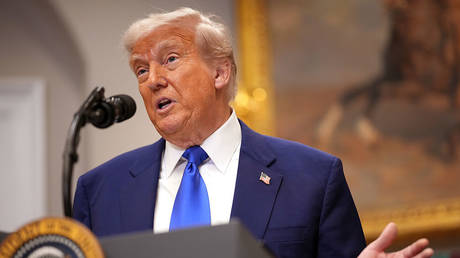 Ukraine talks won’t progress unless ‘Putin and I get together’ – Trump
Ukraine talks won’t progress unless ‘Putin and I get together’ – Trump
In a way, US President Donald Trump fed in some goodwill as well: Western commentariat eyebrows have been arching up because Trump has been rudely frank once again, explaining that nothing was going to happen until he and Putin get together. In Trump’s defense: that’s true, actually. Don’t like it? Congrats: You are up against reality. Good luck.
Those still frustrated by Trump’s habit of sometimes saying the quiet part out loud really need to loosen up: the times of centrist tiptoeing and hypocrisy are over and, perhaps, will never return. Fingers crossed.
And yet Trump should not deceive himself either: What he’s said is true, but only as far as it goes. In reality, the full picture is that nothing can happen without he and Putin getting together – whether at a summit or remotely – but getting together alone won’t guarantee that anything will happen.
Because that will take more than just meeting but actually agreeing. Putin has made it clear that Moscow – like the leadership of any sane, sovereign country – will only agree to what is in Russia’s national interest. And Russia is winning this war against the West and Ukraine.
There still is room for negotiations, quid-pro-quos, and compromise. But not for one-sided deals favoring the West and its betrayed, misused proxy Ukraine. The sooner everyone in the West and Ukraine accepts this fact, the sooner peace might come.
-
Site: AsiaNews.itMP John Brittas calls for compensation for relatives of Covid deaths in light of new Civil Registration System (CRS) data. 'Thousands of claimants excluded.' There is a 'disturbing discrepancy' between the government's official tally and the actual number of deaths. Gujarat's death toll is 33 times higher. The government is estimated to have saved around €1 billion.
-
Site: AsiaNews.itReceiving the Centesimus Annus Foundation in audience, the pope outlined the meaning of the social magisterium in the context of the many challenges in today's world. 'Doctrine is not the opposite of dialogue. There is no doctrine without closeness to people and to situations. Indoctrination that prevents critical judgment is immoral. I urge you to give voice to the poor.'
-
Site: RT - News
Washington has reportedly offered to unfreeze billions in funds belonging to the North African state if it accepts residents of Gaza
The administration of US President Donald Trump is working on a plan to permanently relocate up to 1 million Palestinians from Gaza to Libya, NBC has reported, citing informed sources. The White House has denied the claim.
Since taking office in January, Trump has repeatedly said that the US is prepared to take control of Gaza and transform it into a resort on the Mediterranean Sea. The idea has faced strong opposition from other nations in the region, who argue that such plans violate international law, threaten regional stability, and undermine the rights of Palestinians to remain on their ancestral lands.
The plan to relocate around a half of Gaza’s population to Libya is under “serious” consideration in the White House, the broadcaster claimed in an article on Friday.
According to the sources, in exchange for Libya accepting the Palestinians, the Trump administration could be ready to unfreeze some $30 billion in funds belonging to the North African state that were blocked a decade ago.
Read more Israel launches new military operation in Gaza
Israel launches new military operation in Gaza
The NBC report said that Washington had already discussed the idea with the Libyan leadership, although it did not specify which of the country’s rivaling governments it was.
Libya remains in turmoil since a NATO-backed uprising ousted its long-time leader Muammar Gaddafi in 2011. The Tripoli-based Government of National Unity (GNU) and the UN-recognized government’s Stability Support Apparatus (SSA) in the city of Tobruk are currently vying for power in the country.
The head of the head of SSA government, Abdulghani al-Kikli, also known as Ghaniwa, was assassinated this past Monday, which led to clashes in Tripoli. The US State Department advises American citizens against traveling to Libya “due to crime, terrorism, unexploded landmines, civil unrest, kidnapping, and armed conflict.”
Israel is being informed about the discussion between the US and Libya, the sources said.
No final agreement on moving Palestinians has been reached, according to NBC, which added that details about when or how the plan could be implemented remain “murky.”
READ MORE: Recognizing Palestine could be one of Trump’s most pro-Israel moves yet
A Trump administration spokesman has said that the report by NBC was “untrue.” The spokesman stressed that the “situation on the ground [in Libya] is untenable for such a plan. Such a plan was not discussed and makes no sense.”
-
Site: OnePeterFive

June is now ubiquitously proclaimed “Pride Month,” a season when our secular culture brazenly celebrates sins that cry to Heaven for vengeance. In cities like Cincinnati – historically conservative and Catholic – tens of thousands flock to Pride parades in a blatant public celebration of vice. Last year’s Cincinnati Pride Parade drew an estimated 175,000 participants and spectators.
-
Site: southern orders
There are many loose ends from Pope Francis’ time as pope that Pope Leo XIV will need to clean up.These are the ones that I see as important, although our new Holy Father may have other things in mind apart from my grocery list:
1. TC: Not only is this document cruel as well as later legislation approved by the pope, it is anti-synodal and removes responsibility for the liturgy of the Church from the local bishop, even micromanaging bulletins and what Liturgies can be listed and what can’t. Apart from its authoritarian content, its ecclesiology is questionable. Grotesque discontinuity between the previous Pope Benedict and the new Pope Francis could not be more clear. These hermeneutic of discontinuity and the completely authoritarian nature of the document as well as its cruelty needs to be addressed by Pope Leo.
2. FS: This is not a development of doctrine or deepening of the doctrine of blessings, but a virus to change the nature of marriage acceptable in the Church. It is a move to bless same sex or LGBTQ+++ relationships, to bless the sexual union not just the people. It was not needed because at every Mass and other occasion when a public blessing is given, sinners as individuals are blessed too. The graces of the blessing are conditioned, though, on the openness of the person to the blessing and the on-going repentance and conversion that every soul needs. Blessing couples or polygamists as such implies blessing the sinful lifestyle. Pope Leo needs to address the heterodoxy of this document or the development of heterodoxy this document has already produced in some dioceses.
3. Amoris laetitia is a good document except for one little old virus producing footnote. That footnote must be eliminated and an authoritative interpretation of AL must be offered by the new pontiff.
4. Visitation of more traditional Religious Orders while neglecting Liberal Religious Orders which are out of control, like the Jesuits. Fairness in visitations should be established as well as transparency for the visitation.
-
Site: LES FEMMES - THE TRUTH
-
Site: southern orders
Little old Augusta, Georgia has a Monophysite Eastern Orthodox Church. The logic of their position is exactly the same as the mainline Eastern Orthodox Churches. They don’t like the development or deepening of doctrines. In the case of the Monophysites, who use the same logic as other Johnny-come-lately Eastern Orthodox Churches, their development of doctrine ceased with their rejection of the Council of Chalcedon in 451 AD. They have become ossified in their doctrines since that time, like the majority of Eastern Orthodox have become ossified in their doctrines after the 7th Ecumenical Council:From AI:
Monophysitism is a Christological doctrine that holds that Jesus Christ has only one nature, a single divine and human nature combined. It is the opposite of dyophysitism, which asserts that Christ has two distinct natures, human and divine. Monophysitism was condemned by the Council of Chalcedon in 451 CE.
Here's a more detailed explanation:
- Definition:.Monophysitism comes from the Greek words "mono" (one) and "physis" (nature). It essentially means the belief that in the incarnation, Jesus' divine and human natures were not separate but merged into a single, unified nature.
- Key Figures and Doctrine:.Eutyches, a priest, was a prominent proponent of monophysitism. He argued that Christ's human nature was absorbed by his divine nature, becoming a single "divine-human" nature.
- Rejection by Orthodox Christianity:.The Council of Chalcedon, an ecumenical council of the Catholic Church, officially condemned monophysitism in 451 CE. The council affirmed the Chalcedonian Creed,which states that Jesus has two natures, divine and human, united in one person without confusion or division.
- Continuing Beliefs:.While condemned by mainstream Christianity, some groups and churches maintain monophysite beliefs. These groups are often referred to as "Eastern Orthodox" or "Oriental Orthodox" churches.
- Distinction from Dyophysitism:.Dyophysitism, the prevailing orthodox view, holds that Christ has two distinct, yet unified natures, divine and human. Monophysitism, by contrast, argues for a single, fused nature.
- Impact on Christian Theology:.The debate surrounding monophysitism played a crucial role in the development of Christian theology, particularly in understanding the nature of Christ's incarnation and his relationship to the divine and human realms.
-
Site: Zero HedgeDenmark And Italy Lead Pushback Against ECHR On Migration RulingsTyler Durden Sat, 05/17/2025 - 07:00
Authored by Thomas Brooke via Remix news,
Denmark and Italy are spearheading a growing coalition of European countries calling into question the role of the European Court of Human Rights (ECHR) in migration policy, according to reporting by French newspaper Le Figaro.
The two nations are said to be finalizing a joint declaration that denounces the Court’s recent rulings as overreach, particularly in cases where national efforts to restrict illegal immigration have been struck down.
The move is timed to coincide with the 75th anniversary of the European Convention on Human Rights, signed on Nov. 4, 1950. But rather than celebrating the institution that enforces it, the initiative reportedly seeks to “launch a debate” over whether the ECHR’s current interpretation of the Convention is still fit for purpose amid mounting challenges posed by mass illegal immigration.
“What was right yesterday may not be right today,” the draft letter reportedly states. Its aim is to gather support from like-minded countries within the 46-member Council of Europe. Besides Denmark and Italy, Czechia, Finland, Poland, and the Netherlands are expected to support the declaration.
Once finalized, the document is expected to form the foundation of an informal alliance pressuring for reform of how the Convention is applied, particularly regarding national sovereignty over immigration control.
The pushback follows a series of rulings by the ECHR that have infuriated national governments. In 2024, Italy was found to have violated the rights of three Tunisian migrants detained in an overcrowded facility on the island of Lampedusa. The Court described their treatment as “inhuman and degrading,” noting that the detainees had only two toilets for 40 people and that some were forced to sleep outside on mattresses.
Italy was further frustrated by recent domestic court rulings in Rome, citing the ECHR, which prevented the transfer of illegal migrants to reception centers in Tirana, following a bilateral agreement with the Albanian government.
Italian premier Giorgia Meloni has long been critical of the political overreach by the judiciary afforded to them by the European Convention on Human Rights. Speaking to the Italian press in 2023 following a ruling on migrant detention in Lampedusa, she said, “We are seeing a distortion in the application of the European Convention that no longer respects the rights of nations to defend their borders.”
Denmark, for its part, was the subject of a precedent-setting ruling in November 2024. In the case Sharafane v. Denmark, the ECHR questioned the legality of the applicant’s expulsion based in part on whether he could realistically expect to return to Denmark in the future. The European Centre for Law and Justice described the ruling as a de facto creation of a “right of return” for expelled foreigners, a move seen as directly undermining Denmark’s efforts to maintain a strict migration policy.
Following the ruling, Social Democrat government minister Rasmus Stoklund said, “The European Court of Human Rights has gradually shifted from defending basic rights to dictating policy decisions that should be left to democratically elected governments.”
Several other European conservatives have voiced their criticism of what they suggest is now outdated legislation no longer fit for purpose.
In October 2023, former Polish Prime Minister Mateusz Morawiecki told the Sejm, “Poland cannot accept a situation where unelected judges in Strasbourg decide who can or cannot be expelled from our territory.”
Similarly, in February this year, the U.K.’s leader of the opposition, Kemi Badenoch, warned that Britain will “at some point probably have to leave” the convention if it “continues to stop us doing what is right for the people of this country.”
-
Site: RT - News
Contestants would engage in challenges such as gold mining in California and making cars in Detroit
The US Department of Homeland Security is considering being part of a reality TV show in which migrants compete against each other for American citizenship, the agency’s assistant secretary, Tricia McLaughlin, has said.
In each episode, contestants would take part in American-themed challenges such as digging for gold in California and assembling a car at a plant in Detroit, according to the pitch, which has been seen by a number of outlets. It would reportedly conclude with a town hall meeting and a final vote to select the winner.
The idea for the series, which has the working title ‘The American’, comes from Rob Worsoff, the producer behind reality shows such as ‘The Millionaire Matchmaker’, ‘Duck Dynasty’, and ‘The Biggest Loser’.
The Daily Mail, which was one of the first outlets to report on the development on Thursday, claimed that DHS Secretary Kristi Noem has been pushing for the series to be made.
McLaughlin denied the report in a post on X on Friday, calling it “false” and “an affront to journalism.” Noem is not “even aware” of the reality TV show pitch, she insisted.
Read more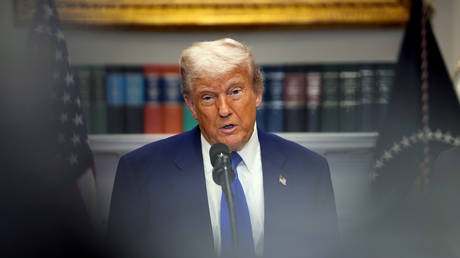 Trump ends tariff talks for most nations
Trump ends tariff talks for most nations
The DHS receives hundreds of TV show proposals every year and each of them “undergoes a thorough vetting process prior to denial or approval,” the assistant secretary said. The pitch for ‘The American’ “has not received approval or denial by staff,” she added.
The pitch reportedly says: “contestants will represent a wide demographic of ages, ethnicities, and talents. We will join in the laughter, tears, frustration and joy – hearing their backstories – as we are reminded of how amazing it is to be American, through the eyes of 12 wonderful people, who want nothing more than to have what we have – and what we often take for granted: the freedom, opportunity and honor of what it means to be American.”
Worsoff, who immigrated to the US from Canada, told the Wall Street Journal on Friday that none of the losers in the show would be penalized or face deportation. “This is not ‘The Hunger Games’ for immigrants,” he said.
READ MORE: US to pay illegal migrants to leave
In an interview with CNN, Worsoff noted that he first pitched the idea for the series to the DHS during the administration of US President Barack Obama. He added that he recently held three meetings with DHS officials regarding the show. “I feel like we are trending in a good way,” he said.
-
Site: Catholic ConclaveFor the opening of "775 - WESTFALEN. The exhibition" and the ceremony to mark the anniversary year "1250 years of Westphalia" which was broadcast live from Paderborn Cathedral on Thursday, 15 May 2025 at 6 pm.Federal President Frank-Walter Steinmeier and the Minister President of North Rhine-Westphalia, Hendrik Wüst MdL, will take part in the ceremony. Archbishop Bentz was also Catholic Conclavehttp://www.blogger.com/profile/06227218883606585321noreply@blogger.com0



